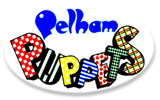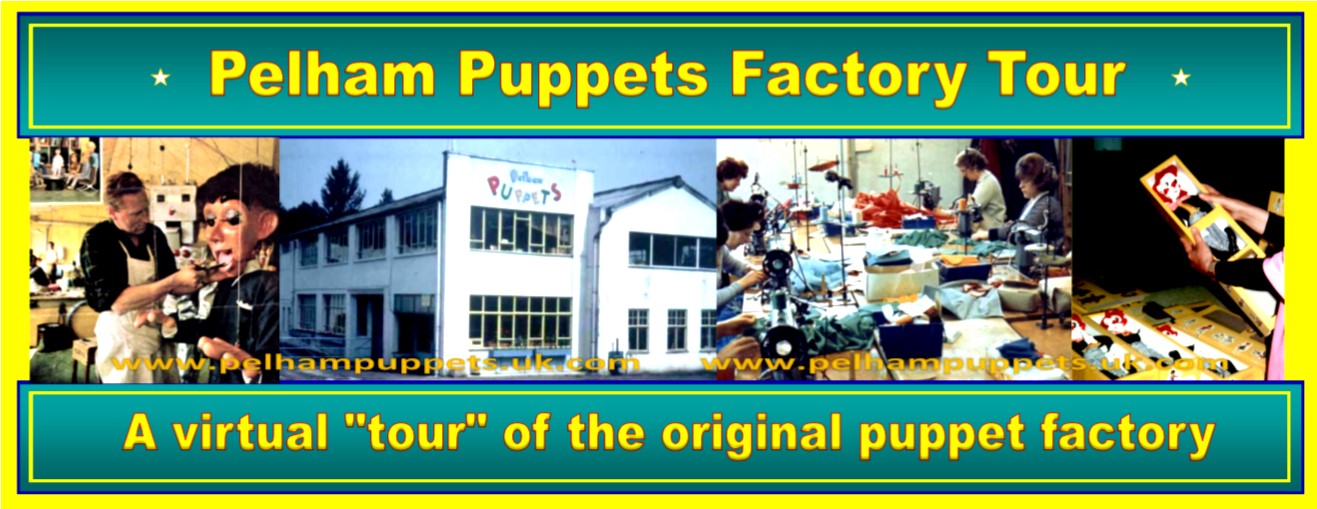
Leaving the Stringing room one would come along a corridor leading to the staircase up to the Display Room or on to the Packing Room, Stockroom and offices. However, before we visit the Display Room and other departments on the first floor of the main building, we need to back track, down toward the Head Painter’s Room.

Between here and the dipping room was the Dougal room where, from 1966, the Dougal hand puppets were assembled by principally by Shirley Hilliers and Alice Shephard. Due to the volume of Magic Roundabout characters required and the fact that most were rod or hand puppets, it became necessary to have them produced in a separate department, where the persons employed here were trained specifically to assemble them.

There was a range of Junior (Type JC) string puppets of the Magic Roundabout characters too and these were assembled on the JC table or by home-workers. In the years following the initial run on Dougal and other hand puppets, the people employed here would also assist in assembling standard bodies and animal bodies when demand required it.
From here we go down through the head painter’s room again where we would come upon a small room which was situated on the far edge of the factory (usually, visitors were not taken into here.) This was where all the moulds for the larger puppet heads, hands, feet and bodies were made and stored.

Above photos: Handel Collins is seen emptying a mould of ‘Revertex’ which is then put into an oven and baked for about two hours. Centre Photo: Sid Long takes some large giraffe and calves to the Display room. Right: some baby Giraffes on display at a Toy fair.
Following the success of the larger than life size puppets in the mid-fifties, a series of smaller display puppets were produced and this small room was where the heads and body parts were produced by Handel Collins. (He would also make the bodies for the life-size puppets using fibre board over wooden cross bar.)
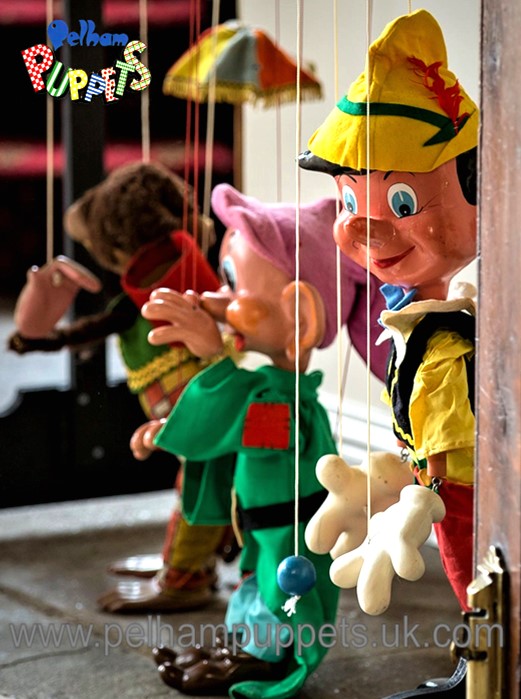 Generally these larger puppets were produced in relatively small numbers and made to special order for shops like Hamley’s, Harrods in London and FAO Schwartz in New York. These included all the ‘Number 2’ range, such as the larger Disney characters such as Snow White and the Seven Dwarfs, various animals, the three feet tall Bimbo and Indian Chief.
Generally these larger puppets were produced in relatively small numbers and made to special order for shops like Hamley’s, Harrods in London and FAO Schwartz in New York. These included all the ‘Number 2’ range, such as the larger Disney characters such as Snow White and the Seven Dwarfs, various animals, the three feet tall Bimbo and Indian Chief.
These were moulded in a latex rubber compound. A cold rubber compound was poured into a Plaster of Paris mould and allowed to stand for about thirty minutes while topping up the level of rubber in the mould from time to time. The liquid in the compound was absorbed into the plaster leaving a skin of solids on the inside of the mould. When the mould was emptied it was placed into an oven for about two hours to dry out. Then the cast was removed from the mould and returned to the oven to dry out still further until it became hard. Once completed, all the parts would be taken up to the display room where Sid Long would build in the moving parts to the heads, such as eyes.
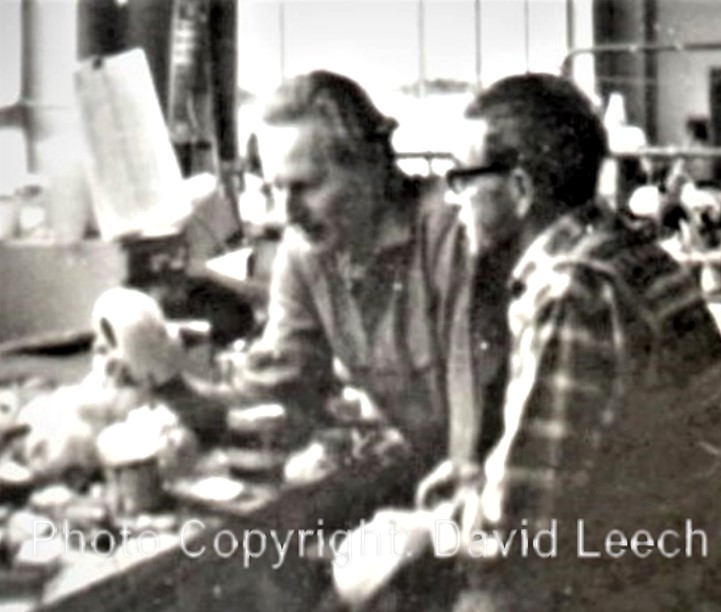 Sid told me, “I would fix the eyes in and Mr Pelham would usually do the jaws. Some of the puppets like the very large clowns and animals would have floppy ears, a wobbly nose or a top hat that would flop about as well.” The photo shows Sid and Mr Pelham discussing the design of a Vent or “No 2” head in 1969 in the Display Room.
Sid told me, “I would fix the eyes in and Mr Pelham would usually do the jaws. Some of the puppets like the very large clowns and animals would have floppy ears, a wobbly nose or a top hat that would flop about as well.” The photo shows Sid and Mr Pelham discussing the design of a Vent or “No 2” head in 1969 in the Display Room.
The moulds for the special, ‘one-off’ puppets made in the 1950s and early 1960s were cast by Handel too, including the puppets for Rene Strange who used them on stage and TV. Sid explained, “The legs for the ‘Drunk’ used by Rene were made from the rubber respirator tubing, so his legs wobbled when he walked. The Opera Singer had a heaving bosom, there was a horse that would blow his nose and the Stripper was made with pins that could be pulled out by the strings, so her clothes would fall off and her bra, that was held in place by elastic, would pop off when the string was pulled too!” You can see Rene with the puppets in action here.
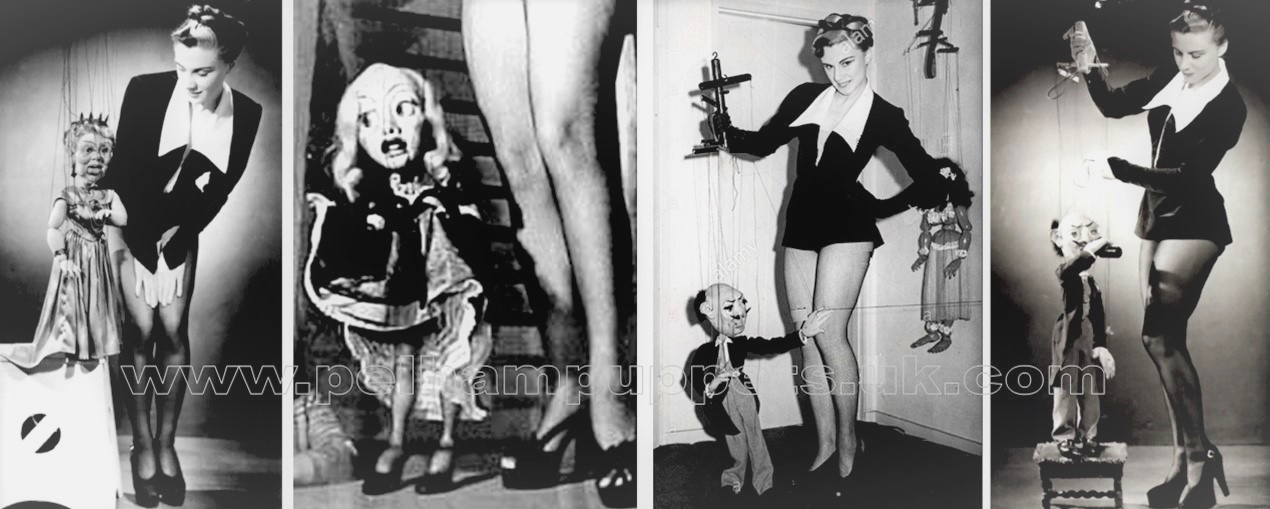
In addition to Handel Collins, other people who worked in this room over the years, included Frank Lawton and David Alexander. David was a very talented artist and painted scenery for some professional theatrical productions and he also painted the scenes for the early animated display units too, (later, Mrs Pelham and Pam Lawton would paint these.)

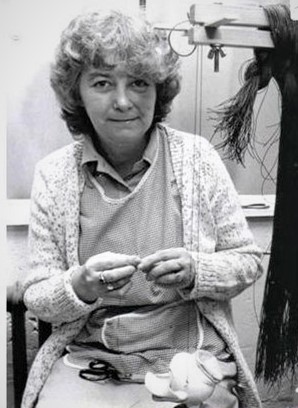 The Display Room. The large display puppets were produced in here and one would often see the puppets hanging around from chains and beams suspended from the ceiling. Mary Lester was the head of department and was fully occupied with stringing and assembly work which she had done from the time she started in 1968. She was also responsible for the factory employee “tuck shop.” The photo shows Mary stringing a Donald Duck.
The Display Room. The large display puppets were produced in here and one would often see the puppets hanging around from chains and beams suspended from the ceiling. Mary Lester was the head of department and was fully occupied with stringing and assembly work which she had done from the time she started in 1968. She was also responsible for the factory employee “tuck shop.” The photo shows Mary stringing a Donald Duck.
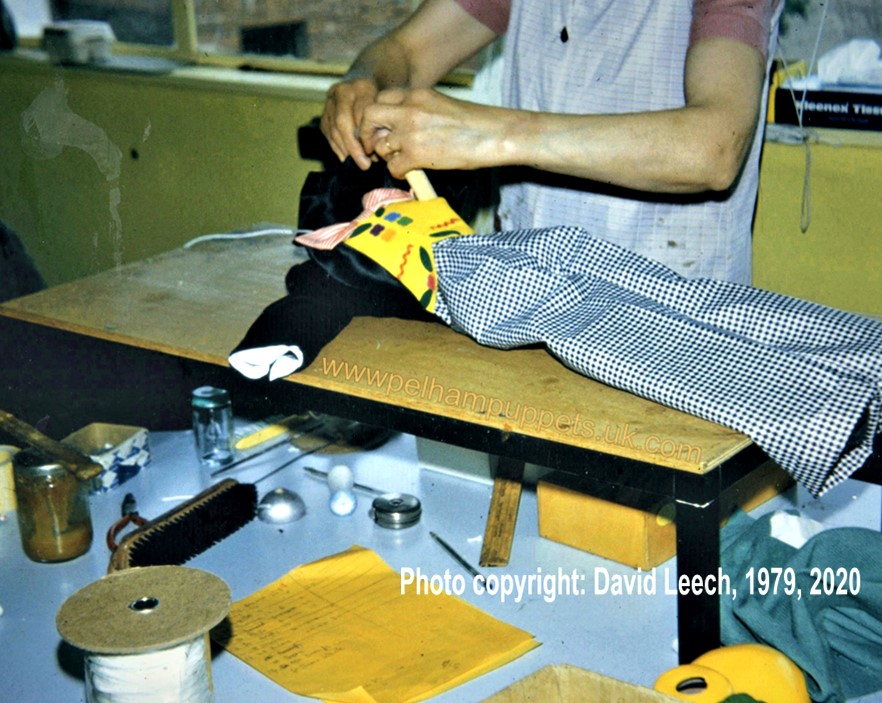 Upon entering the Display room, one would first come across a group of head painters including Sylvia Fry, Linda Sallows and Debbie Simpson. They painted the larger, ‘No.2’ heads and faces of the vent puppets, these girls would also paint the bodies for the No.2 giraffes and other large range animals. Along from this table one would find two sewing machines operated by Cess Harris and Helen Fry, who were responsible for making the costumes for such puppets as the three feet tall Bimbo and larger Disney characters like Snow White and the seven dwarfs. ‘Emu’ and Dolly Birds were assembled here too. The photo shows Helen Fry, dressing a No 2 Bimbo.
Upon entering the Display room, one would first come across a group of head painters including Sylvia Fry, Linda Sallows and Debbie Simpson. They painted the larger, ‘No.2’ heads and faces of the vent puppets, these girls would also paint the bodies for the No.2 giraffes and other large range animals. Along from this table one would find two sewing machines operated by Cess Harris and Helen Fry, who were responsible for making the costumes for such puppets as the three feet tall Bimbo and larger Disney characters like Snow White and the seven dwarfs. ‘Emu’ and Dolly Birds were assembled here too. The photo shows Helen Fry, dressing a No 2 Bimbo.
The photos below show how the 3ft tall Bimbo was made. On the left Keith is assembling his body. The legs are made using the rubber respirator tubing that Bob obtained in 1947 from his friend in the Army Surplus Stores. The tubing, originally for gas masks during the 2nd World War was stored in wooden boxes wrapped in water-proof paper, so even after 25 years, the rubber was still soft and pliable for use in making limbs. The next photo shows Cecily (Cess) Harris making Bimbo’s clothes. These were beautifully tailored clothes suitably lined inside and made to the highest standards. Next Linda Sallows is painting Bimbo’s face and on the right, we see Helen dressing and assembling him and adding his thick, orange rug-wool hair one strand at a time. (See the close-up colour photo above.) Once he’s assembled and dressed his strings are added. Unlike the smaller standard puppets, thick, white cord is used and he has no leg strings.

Below are pages from the Tiderider USA catalogue (1980) featuring the range of large puppets and Vent puppets that were mainly produced in the Display Room and the adjacent rooms.

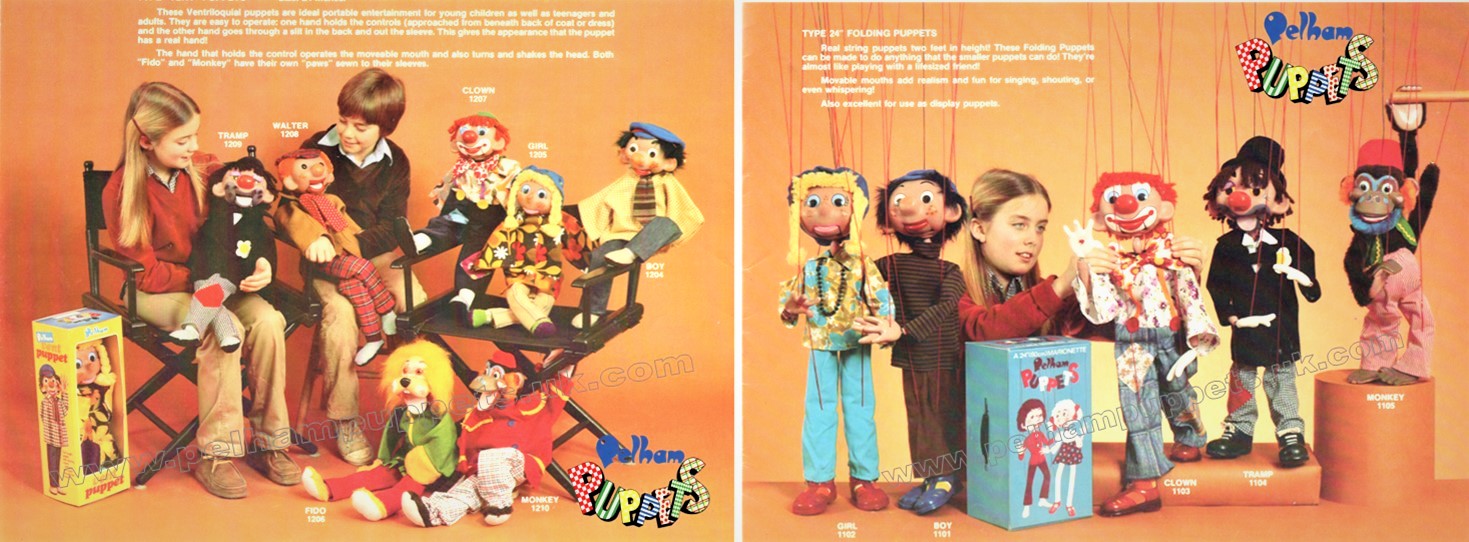
The photo below left, taken in the early 1980s, is Grenville Hodge, holding Mickey and Minnie Mouse. Bob needed to have a complete review of the costs involved in producing the puppets and some methods of production needed streamlining and he wanted to explore ways to try and increase production while maintaining or reducing costs. So, Grenville was brought into the factory as the Works manager in July 1977. After Mr Pelham died in June 1980 he took over general management of the factory, referring back to Mrs Pelham (at home,) on a regular basis.
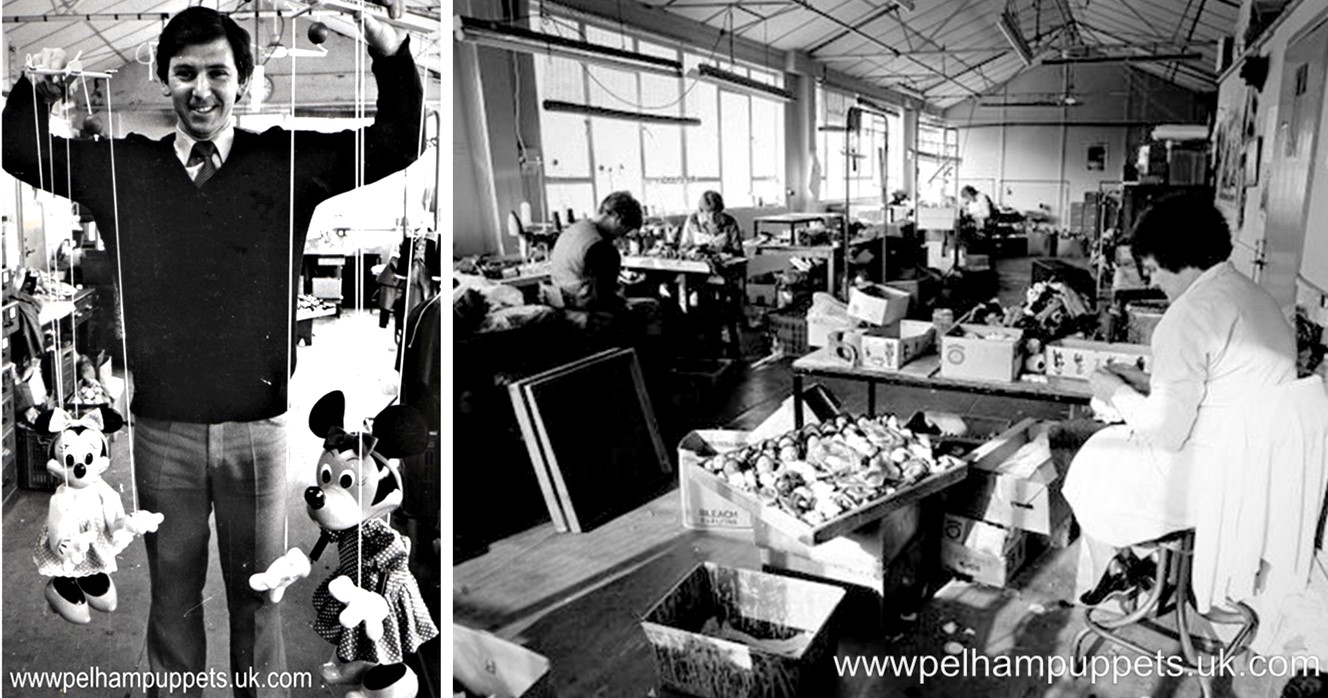
The photo above right is Doris Wyatt who is dressing some standard puppets. Doris started working in the factory in 1970 although she (like many others) began by taking on homework for several years and was department head of the JC and Animal Room that was through the staff canteen next door to the Display room,
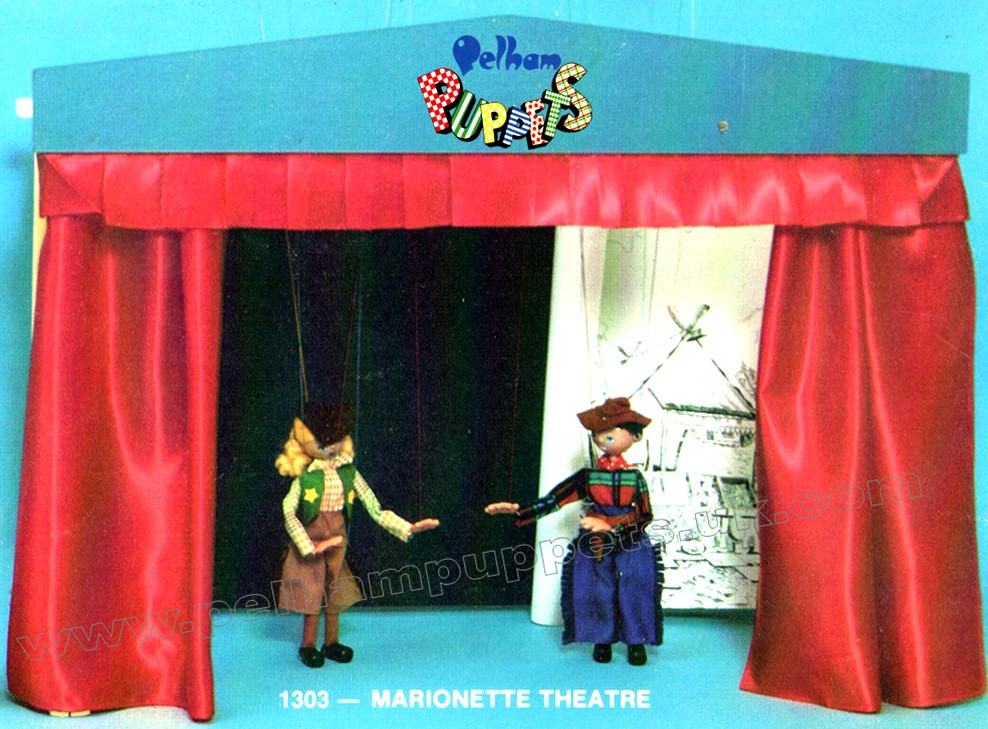 This room was dominated by three very large tables one called the ‘dragon table’ one the ‘animal table’ and the other called the ‘JC table.’ As the names suggest, this is where Mother Dragons and other animal range puppets and larger puppets requiring non-standard, wooden bodies, such as the giant, king, queen and wolf and the junior range puppets were assembled and strung. Also, in this room Gladys Weir would be busy making and attaching the curtains to the portable puppet stages. The wooden parts for the stages were made in the Machine Room. Gladys would then box them up too before they were taken down to the Production Room and Stock Room.
This room was dominated by three very large tables one called the ‘dragon table’ one the ‘animal table’ and the other called the ‘JC table.’ As the names suggest, this is where Mother Dragons and other animal range puppets and larger puppets requiring non-standard, wooden bodies, such as the giant, king, queen and wolf and the junior range puppets were assembled and strung. Also, in this room Gladys Weir would be busy making and attaching the curtains to the portable puppet stages. The wooden parts for the stages were made in the Machine Room. Gladys would then box them up too before they were taken down to the Production Room and Stock Room.

Returning back through the canteen and before going back into the display room, one would enter the Vents and Mini-units Room. Here there were shelves of boxes containing completed No.2 range puppets and over by the front windows a set of tables where you would find Andrew Witts working on the mini animated display units, along with Keith Huntley assembling the No.2 bodies and vent puppets.
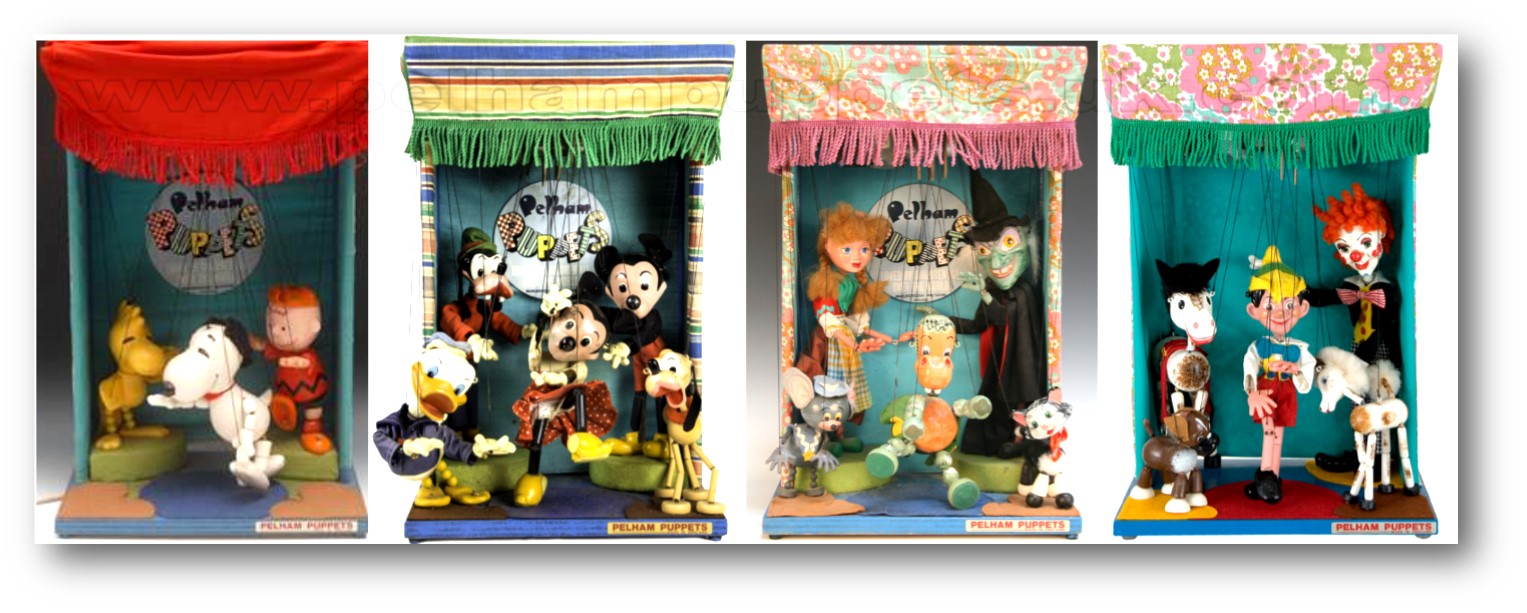
Above: Some of the Mini-Units built by Andrew Witts from the mid 1970s.
From 1975, Andrew Witts also installed the puppets into the Mini Units as can be seen in the photograph below, on the right and in the centre he is fixing the plate on which the motor will be mounted. The motors were added by Michael and Andrew Watts down in the maintenance workshop next to the Animated Hall. Keith is behind him working on some dwarf bodies. The photo left, Sid Long is working on a No 2 Pinocchio head, adding the large screw eyes for the head strings and the tubing for the nylon thread that was used to hold his head and body together.

When the vent puppets were introduced in 1968, they had moulded heads, made from a very thick pumice mixture and the jaws and top of the head, (referred to as domes,) were made from the standard thinner mixture. It would take up to four weeks from the head being moulded until the puppet was completed and even though they were made in batches of twenty five to thirty, a quicker way of making them was needed in order to keep up with demand. In addition, these larger heads would not always hold their shape for the fitting of the jaws, so the decision was made a change to plastic heads a couple of years later at about the same time that legs were added.
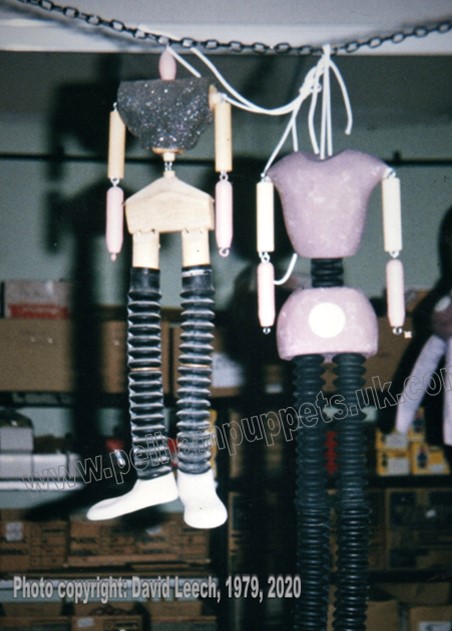 The photo shows two larger puppet bodies waiting to be dressed. The smaller one on the left of the photograph was for a No.2 character, such as the boy, girl, clown or monkey. The taller one on the right was the body for No.2 Bimbo or the Indian chief or Gepetto. Note the gas mask, rubber respirator tubing that were used for the legs.
The photo shows two larger puppet bodies waiting to be dressed. The smaller one on the left of the photograph was for a No.2 character, such as the boy, girl, clown or monkey. The taller one on the right was the body for No.2 Bimbo or the Indian chief or Gepetto. Note the gas mask, rubber respirator tubing that were used for the legs.
Bob would spend much of his working day in the Display Room, usually working on prototypes or devising other construction methods for the puppets. It was a convenient place for him to work, since there was a centre stairway leading down to his office, that allowed him quick access should he be called away to answer the telephone or greet unexpected visitors.
The Display Room was formed in 1954 when the Harrod’s Toy Buyer asked Bob for a life size puppet for the Toy Department as a special display attraction that Christmas. The result was a clown called Bimbo and he stood nearly 7-feet tall. He was a great success in Harrods and over the following years many larger than life puppets were made, including Giraffes, Elephants, Unicorns, Ostriches and other animals.
The photograph below of the giraffes appeared on the front page of the local paper, the Marlborough Times in 1961. It was another 20 years before newspapers regularly carried colour photographs, but this indicates the high esteem that Pelham Puppets was held in the local community.
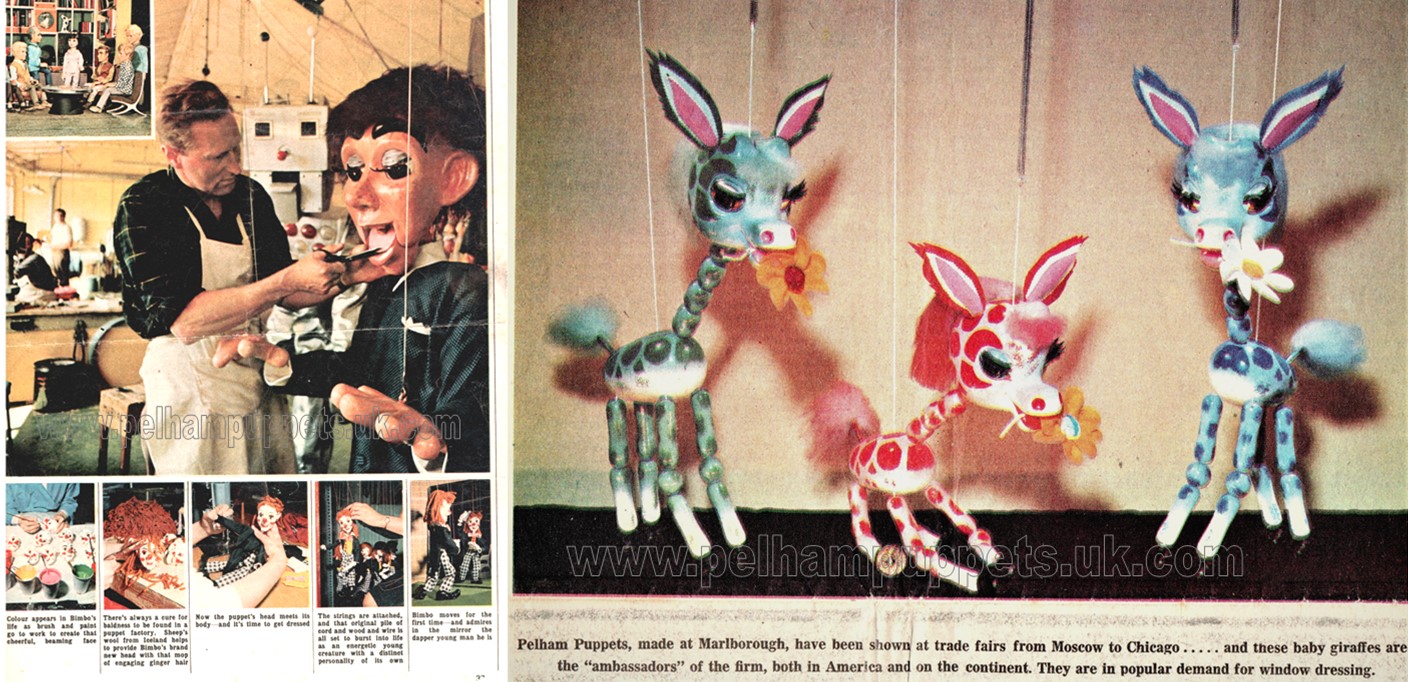
Many of the Type SM characters were made as life-size display puppets and even a Robot was produced. You can just see the Robot behind Bob in the photo where he’s putting the finishing touches to the Pop Singer puppet in 1965. (The Story of Bimbo will be added to the website soon.) With such a variety of large and colourful characters produced in this room, it was a very popular place for Bob to bring visitors, particularly the press and television people, since this bright and airy room always reflected the colour and fun created by Pelham Puppets.
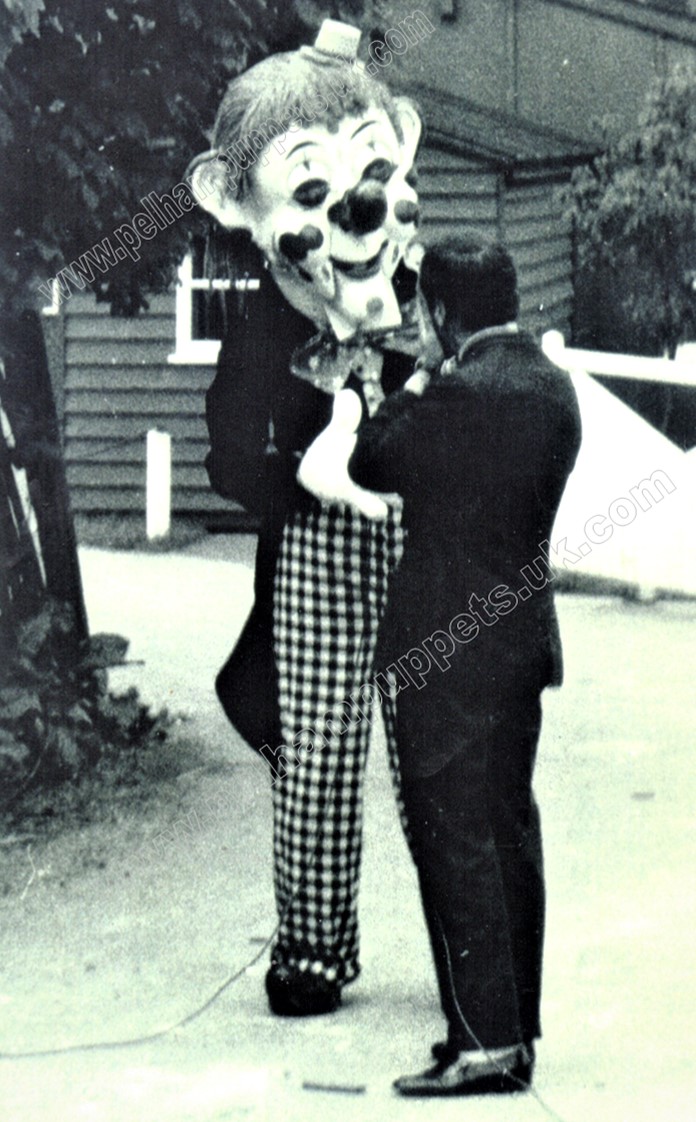 One example of this was a few months after the factory fire of 1961. The new factory became the subject of a regional television programme, “Day by Day” at a time when the Display Room was occupied by several of the life size giraffe and other puppets.
One example of this was a few months after the factory fire of 1961. The new factory became the subject of a regional television programme, “Day by Day” at a time when the Display Room was occupied by several of the life size giraffe and other puppets.
The Producer, Terence Carroll, was greeted by a very unusual sight when he arrived at the factory one day in 1962. Bob related what happened in Pelpup News No. 3 Summer 1962 issue: “I gave the TV producer, Terence Carroll and his crew a bit of a shock when they came to film at our factory for the “Day by Day” regional ITV programme. I dressed up in this Bimbo outfit and greeted him and his team at the door. The mouth and the eyes in the head mask were controlled from a gadget in each hand so that the mouth can be made to work exactly with my speech. The result was very effective and Mr Carroll confessed he was dismayed and shocked at the greeting!”
The photos below show, from left to right: In the foreground, we see TV Producer Terence Carroll talking to Peter Carter-Page. In the centre of the photo, we see Sid Long with Shirley Louth watching her daughter play with the large Giraffe Centre photo: Peter standing behind Bob Pelham who is demonstrating to young Stephen Louth how to get the puppet to dance in front of the TV camera. The photo on the right Peter is holding a No 2 Indian Chief and Patsy Hands who is holding a No 2 size Huckleberry Hound while chatting to Terence the TV Producer.

The two images below are two photos looking through the TV monitor. The left photo shows Handel Collins working on a No 2 size puppet. The photo right, again looking through the monitor is of the new sewing room, (L-R): Mrs Cox, Mrs Hams, behind her leaning over is Mr Pelham, Pam Hams, Vera Skinner and Beryl Lewis.
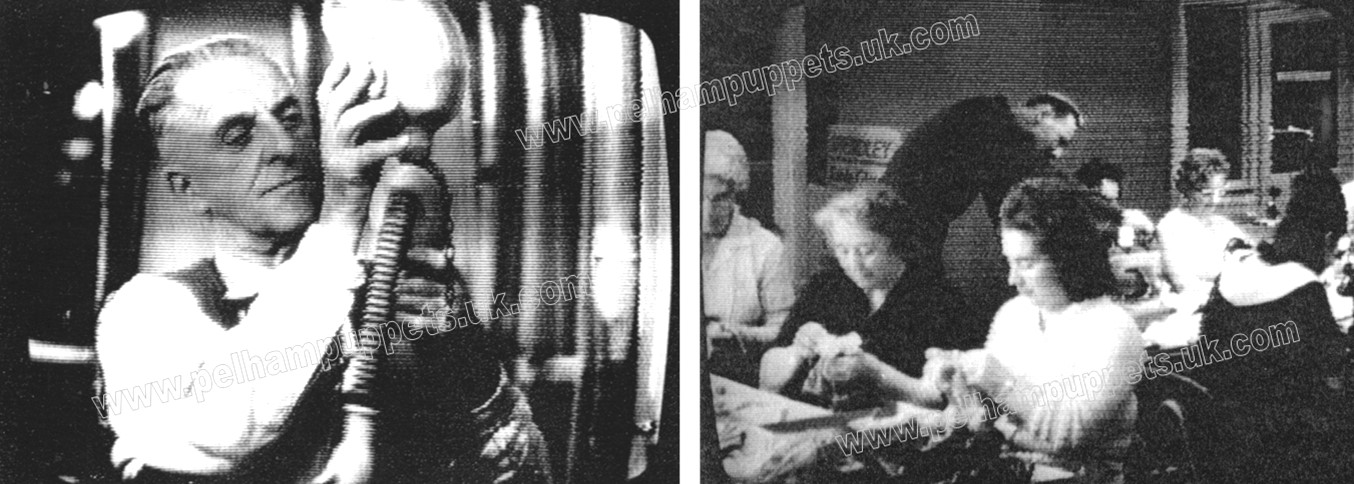
The Display room was certainly a bright and lively place to work in most of the time and the atmosphere was pretty relaxed throughout the factory, Bob would not tolerate “slackers” or wastage. Everyone worked well and quickly.
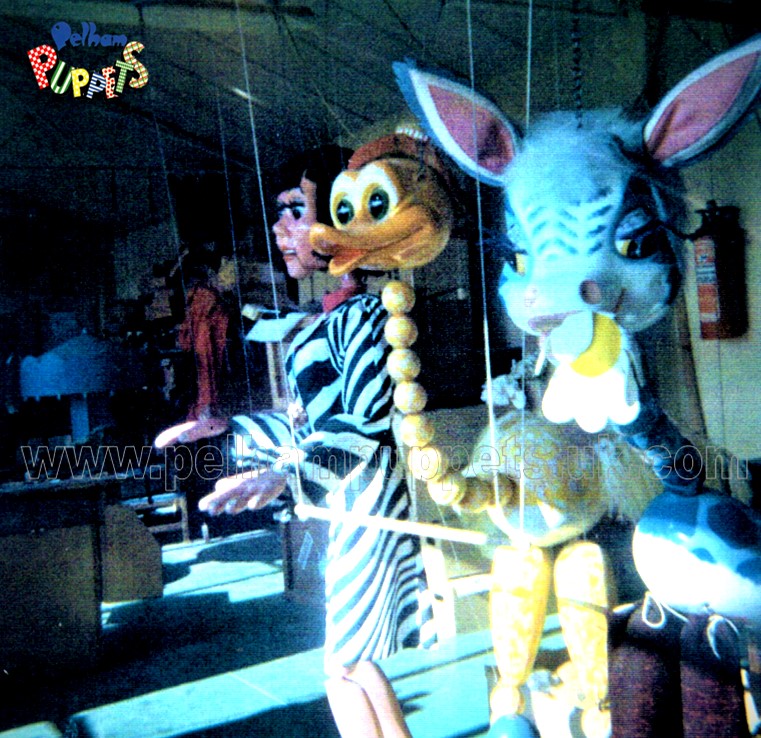 For the main part, the dedication and enthusiasm of long-standing employees rubbed off on newcomers. Everyone had their own corner or space and one or two even brought in their pets including a Labrador and a German Shepherd dog. During the summer months it was possible for some to work outdoors, alongside the River or some would set themselves up in the courtyard with tables, bits’n’pieces and cold drinks! Mr Pelham would wander through, offer some corny joke about puppets getting sunburnt and sometimes sneak in a quick drink when the ladies were not looking! Joan, the Forewoman also told me a story about a ‘saw-dust’ battle between the staff of two departments that came to an abrupt halt when Bob unexpectedly appeared! “For one horrifying moment,” she recalled, “Nobody quite knew what to say – until Mr Pelham took sides and joined in!”
For the main part, the dedication and enthusiasm of long-standing employees rubbed off on newcomers. Everyone had their own corner or space and one or two even brought in their pets including a Labrador and a German Shepherd dog. During the summer months it was possible for some to work outdoors, alongside the River or some would set themselves up in the courtyard with tables, bits’n’pieces and cold drinks! Mr Pelham would wander through, offer some corny joke about puppets getting sunburnt and sometimes sneak in a quick drink when the ladies were not looking! Joan, the Forewoman also told me a story about a ‘saw-dust’ battle between the staff of two departments that came to an abrupt halt when Bob unexpectedly appeared! “For one horrifying moment,” she recalled, “Nobody quite knew what to say – until Mr Pelham took sides and joined in!”
In 1978 about 1,200 puppets would be completed every day. When the weekly turnover exceeded £20,000, every employee received a percentage bonus in their pay packet. Team effort was required and rewarded.

The image above is of four screen shots of a film made by an employee in 1966. The film depicts Bob taking you on a tour of the factory and these images show, the Display room was occupied by over a dozen large clowns and animals. On the far right is a still of Bob explaining the production process. In the next image along we can see Sid Long making final checks to one of the giant puppets. To see all these larger than life puppets in action, dancing around is a sight to behold.
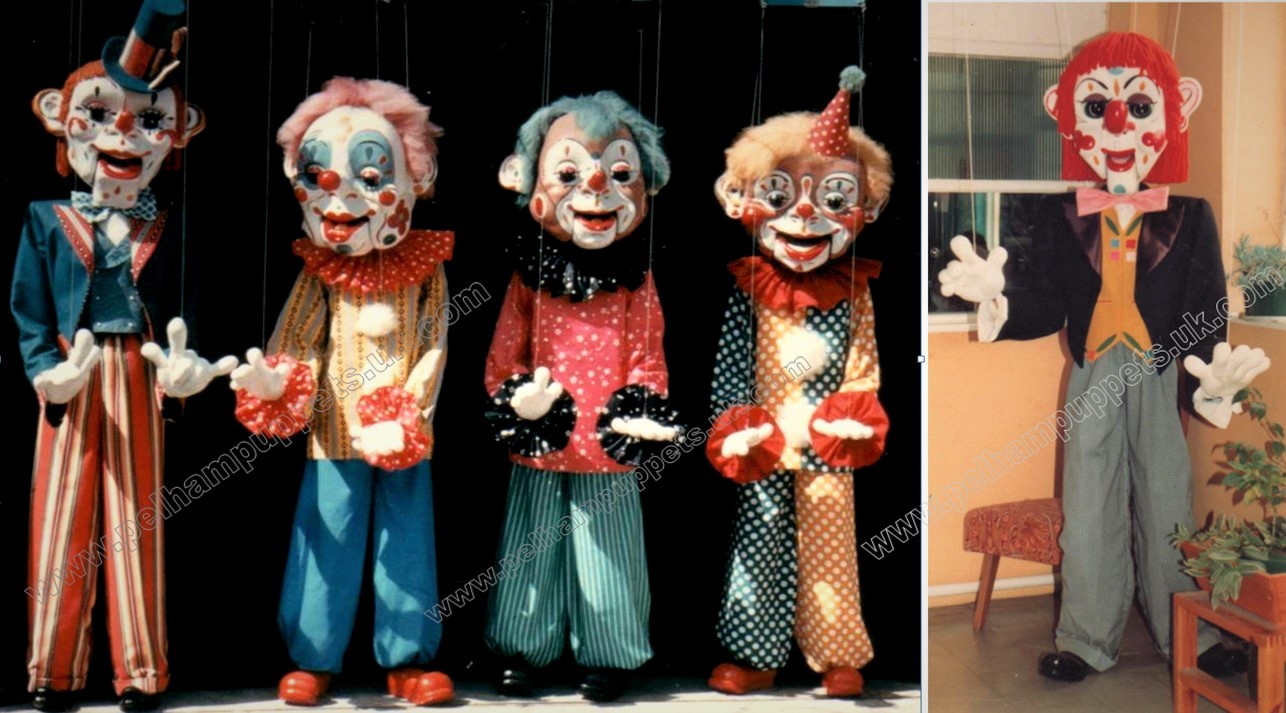
Photo above: Giant puppets in the summer of 1957. On the left is ‘Uncle Sam.’ These were destined for Chicago USA. One hundred puppets made up a single Order, twenty-five of each puppet. The photo on the right, taken in June 1980, is Bimbo in the factory reception.
Exiting the Display room, down the stairs, there was the Packing and Dispatch Room headed by Pam Masters, where the Orders came in after being processed in the office. By the late 1970’s export Orders exceeded the home market considerably and a single order could consist of up to 200 cartons containing 48 puppets each, sometimes more. These would be loaded onto a container lorry twice a week and all the men in the factory, including Mr Pelham himself, would be called upon to help with loading the containers.

The remaining departments yet to be described are the storerooms ably cared for by Norman Giles for many years and the animated hall on the other side of the river, across the footbridge.In the stores were all the materials for puppet manufacture ranging from huge rolls of fabric for costumes, together with boxes of fabric pattern books, sacks of wooden balls and other components needed for the great variety of puppets produced and the tools needed for their manufacture.
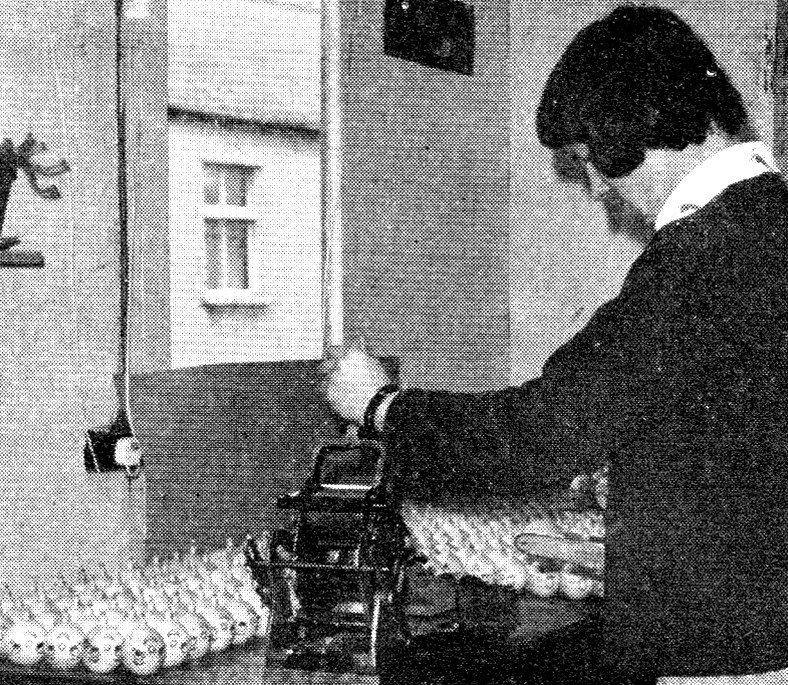 Adjacent to Mr Giles’s office was a room with a small worktop and a specially made hand-printing machine that consisted of a set of inked rollers that was used for printing the faces on to the wooden ovals for the ‘Woodenhead Range’ of puppets. The photograph shows Henry Britten rolling faces onto the wooden ovals.
Adjacent to Mr Giles’s office was a room with a small worktop and a specially made hand-printing machine that consisted of a set of inked rollers that was used for printing the faces on to the wooden ovals for the ‘Woodenhead Range’ of puppets. The photograph shows Henry Britten rolling faces onto the wooden ovals.
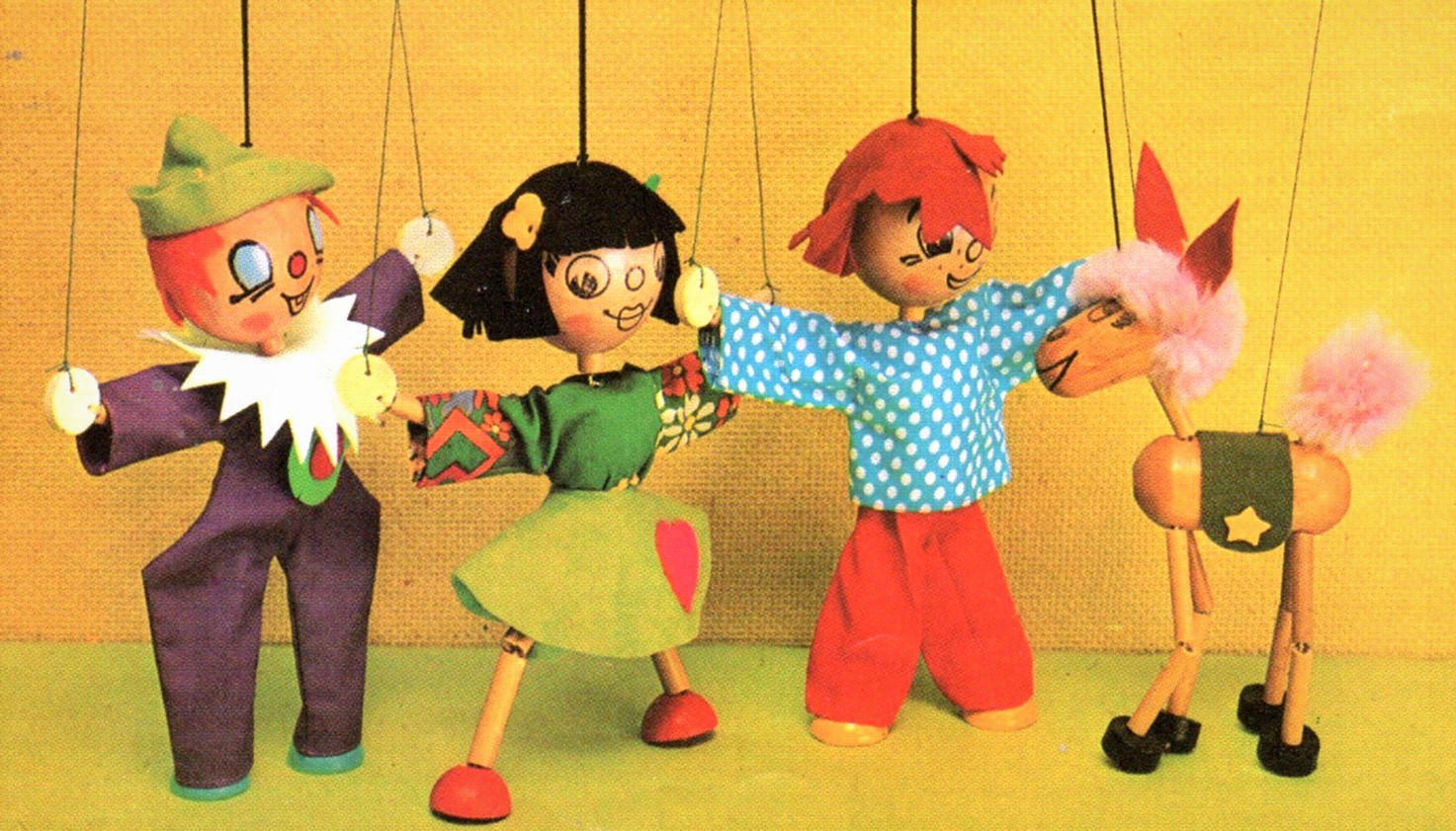 The rollers covered with Indian ink ran over a flat metal plate with facial features raised onto it. When the roller passed over the plate, it left a thin film of ink on the raised parts. This was stamped onto a rubber pad. Using a specially made handheld clamp, a wooden oval was rolled over this pad, transferring the face to the surface. Once dry, the heads with these printed faces went to the dipping room, to be coated in clear varnish and on to the head painters who hand painted in some of the facial features.
The rollers covered with Indian ink ran over a flat metal plate with facial features raised onto it. When the roller passed over the plate, it left a thin film of ink on the raised parts. This was stamped onto a rubber pad. Using a specially made handheld clamp, a wooden oval was rolled over this pad, transferring the face to the surface. Once dry, the heads with these printed faces went to the dipping room, to be coated in clear varnish and on to the head painters who hand painted in some of the facial features.
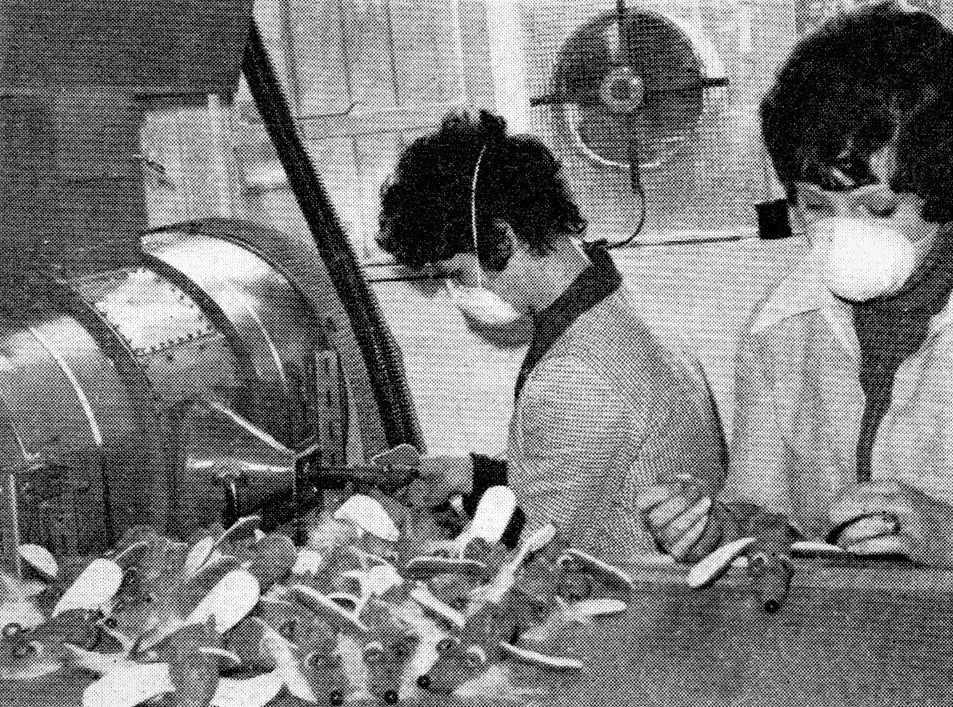 Continuing passed the office and along the corridor through two other store rooms one would come across another room, (which was originally built as an office following the fire in 1961,) which housed a large metal drum with an even larger wooden box above it. This was the Womble Room. In the photograph you can just see the drum on the left of with Jenny Fraser and Sue Hedges and a pile of Womble heads on the table.
Continuing passed the office and along the corridor through two other store rooms one would come across another room, (which was originally built as an office following the fire in 1961,) which housed a large metal drum with an even larger wooden box above it. This was the Womble Room. In the photograph you can just see the drum on the left of with Jenny Fraser and Sue Hedges and a pile of Womble heads on the table.
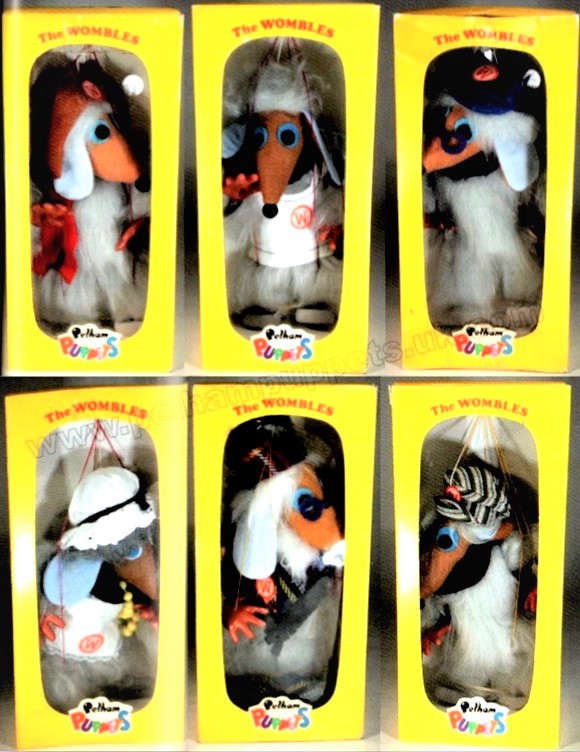 The overhead box contained the stuffing material which was drawn into the drum by suction caused by compressed air and out through a nozzle which points toward the operator. When the ‘empty’ Womble head was held over the nozzle and the foot pedal which controlled the compressed air was pressed, the stuffing material was blown into the head. Once filled, the head was tied off with a run-through string. This was used for filling the legs for the Vent puppet legs as well. Although the whole process was well ventilated the operators, wore masks as an extra precaution against the dust from the chopped foam stuffing. At first, Bob had a problem finding enough workers to meet the demand for Womble puppets in 1975 and many employees were taken from their usual work and switched to help with the assembly and production of thousands of Wombles both within the factory and many home-workers were trained in stringing and packing the puppets at home too.
The overhead box contained the stuffing material which was drawn into the drum by suction caused by compressed air and out through a nozzle which points toward the operator. When the ‘empty’ Womble head was held over the nozzle and the foot pedal which controlled the compressed air was pressed, the stuffing material was blown into the head. Once filled, the head was tied off with a run-through string. This was used for filling the legs for the Vent puppet legs as well. Although the whole process was well ventilated the operators, wore masks as an extra precaution against the dust from the chopped foam stuffing. At first, Bob had a problem finding enough workers to meet the demand for Womble puppets in 1975 and many employees were taken from their usual work and switched to help with the assembly and production of thousands of Wombles both within the factory and many home-workers were trained in stringing and packing the puppets at home too.

The Animated Hall and Factory Workshop.
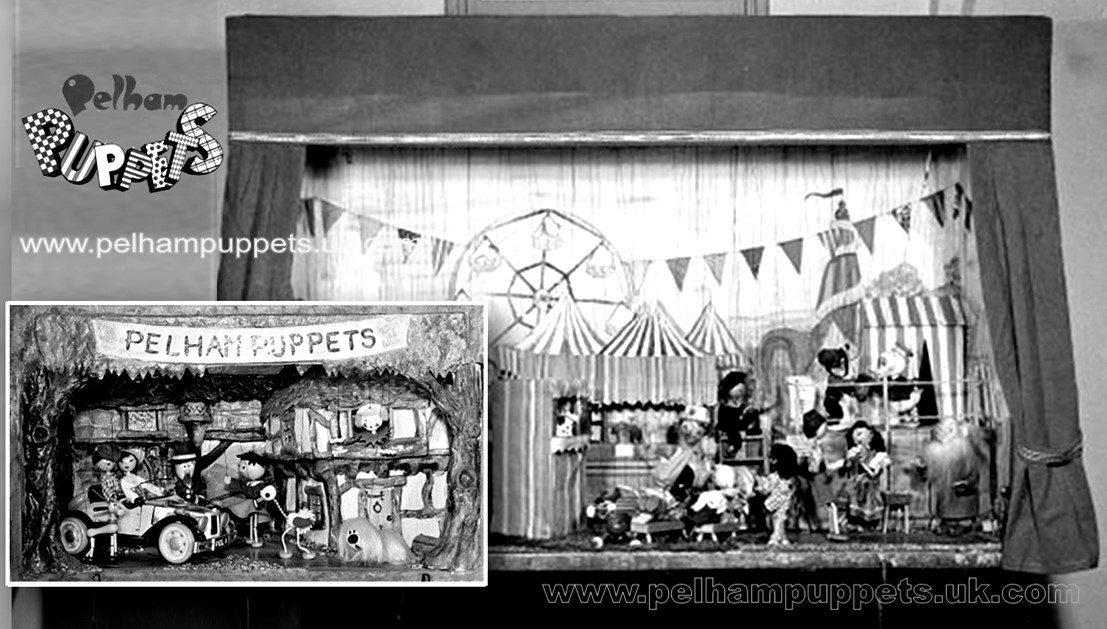 This was where the animated display scenes were produced. It was the largest room in the factory and for a time also housed a puppet theatre that I designed and was built by the factory carpenter, Joe Crook. The Animated Units came in two sizes, the small units which were three and a half feet wide and two feet high and the large units, which were six feet wide and four feet high. The large units could sometimes be set side by side to make up one complete scene 18 feet wide like the ‘Hostelry’ or Gulliver’s Travels. The scenery was painted onto hardboard by Bob’s wife Anne and Frank Lawton’s wife, Pam and Bob would bring them into the Hall then along with the plywood floor, these were attached to the frames. The lights, dexion rocking bars and motors were installed after the scene had been built in, leaving plenty of room for the motor in the back, right side corner.
This was where the animated display scenes were produced. It was the largest room in the factory and for a time also housed a puppet theatre that I designed and was built by the factory carpenter, Joe Crook. The Animated Units came in two sizes, the small units which were three and a half feet wide and two feet high and the large units, which were six feet wide and four feet high. The large units could sometimes be set side by side to make up one complete scene 18 feet wide like the ‘Hostelry’ or Gulliver’s Travels. The scenery was painted onto hardboard by Bob’s wife Anne and Frank Lawton’s wife, Pam and Bob would bring them into the Hall then along with the plywood floor, these were attached to the frames. The lights, dexion rocking bars and motors were installed after the scene had been built in, leaving plenty of room for the motor in the back, right side corner.
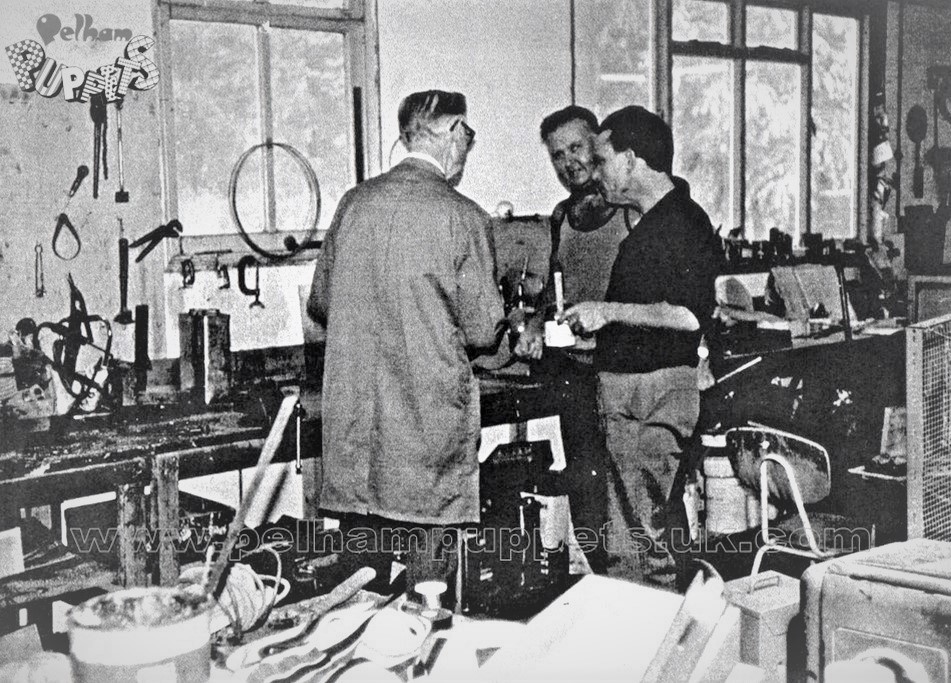 Photo: The workshop was next to the hall, here we see Norman Giles, (stores manager,) Jo Crook (carpenter) and Michael Watts (machine maintenance.)
Photo: The workshop was next to the hall, here we see Norman Giles, (stores manager,) Jo Crook (carpenter) and Michael Watts (machine maintenance.)
By the time I started working full time in 1977, orders from overseas for the display units increased considerably. In fact, the first job I was given to do was to fulfil an Order from Holland for 15 Units. The scene included a windmill, a bridge over a canal and a boat coming out from under the bridge. The “Windmill Scene” had been produce the year before, (see photo,) and the Dutch customer (a chain of toy shops,) like it so much, they wanted one for every shop they had. (Mr Pelham joked that if I completed them before the order deadline, I would ‘win’ a free trip to see the tulip fields! The Order was completed in time but I never got to see the tulips!)
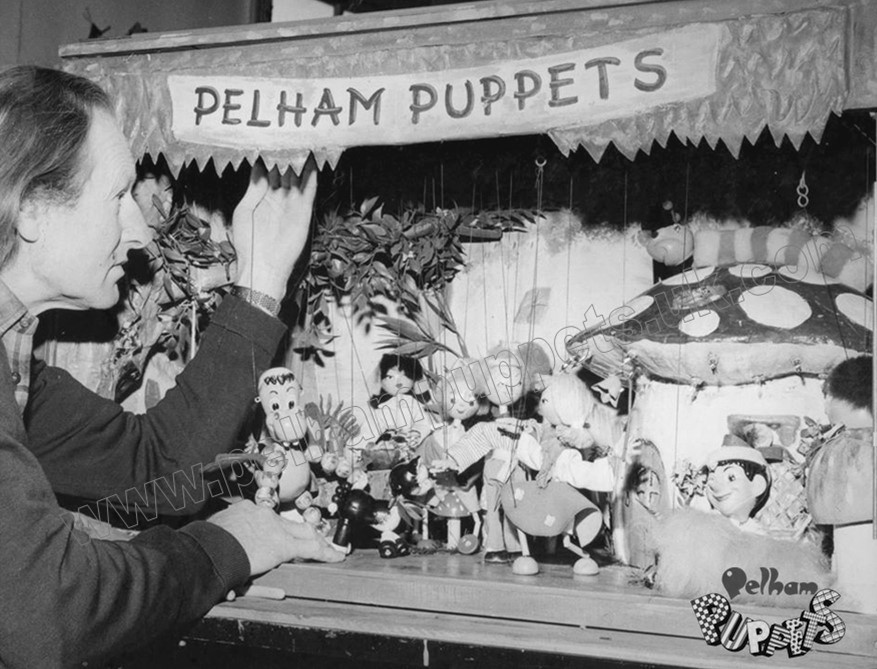 Prior to this time, Bob used to create all the scenes himself spending the last hour or two each day working on a display unit. He found it quite relaxing thinking of ways to give each puppet ‘something to do.’ The aim was to ensure that each character was involved in some kind of activity and not simply jigging about aimlessly. The photo shows Mr Pelham working on the “Mushroom” animated display unit in 1976.
Prior to this time, Bob used to create all the scenes himself spending the last hour or two each day working on a display unit. He found it quite relaxing thinking of ways to give each puppet ‘something to do.’ The aim was to ensure that each character was involved in some kind of activity and not simply jigging about aimlessly. The photo shows Mr Pelham working on the “Mushroom” animated display unit in 1976.
Sid Long used to help with refurbishing the display units in previous years but Mr Pelham told me that I was the first person he employed to build the scenes and install the puppets from start to finish.
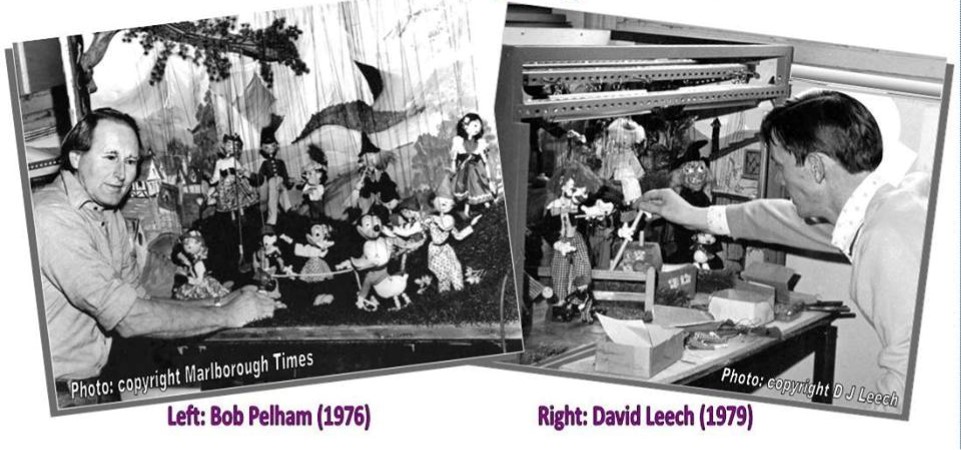
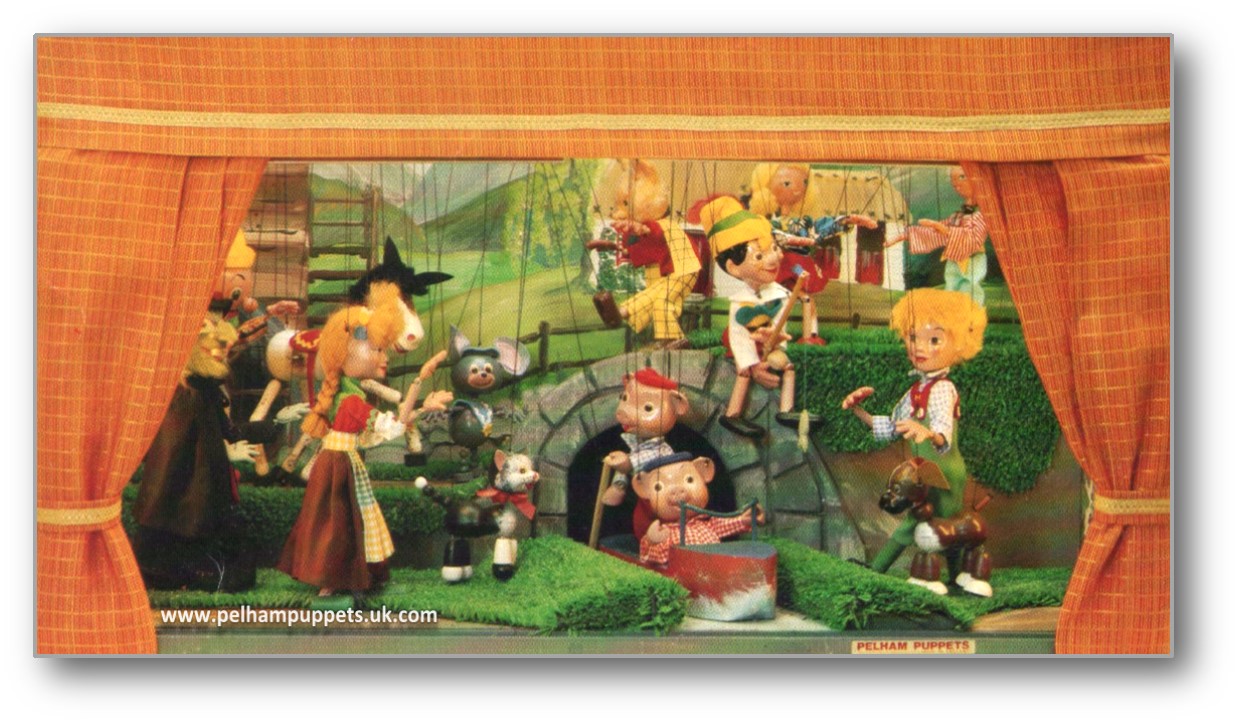 It could take up to three weeks to complete one of the large display units, since it took considerable time to make the props, build the scene and set the individual puppets into a position so that they didn’t knock against another puppet or one of the props. If a puppet’s arm did tap the side of the painted scene for example, the constant repetitive movement would not only create an annoying noise but would eventually wear away the paint and even erode the board it was painted on altogether. The same would happen if one puppet constantly hit against another puppet. On one occasion, when a unit had been hired out for twelve months and had been in almost constant use, the moulded head of one character had half its head missing! The hand of the puppet next to it had been repeatedly hitting the face and had worn it away. The slightest adjustment in the position or tension of a string could alter a particular movement considerably.
It could take up to three weeks to complete one of the large display units, since it took considerable time to make the props, build the scene and set the individual puppets into a position so that they didn’t knock against another puppet or one of the props. If a puppet’s arm did tap the side of the painted scene for example, the constant repetitive movement would not only create an annoying noise but would eventually wear away the paint and even erode the board it was painted on altogether. The same would happen if one puppet constantly hit against another puppet. On one occasion, when a unit had been hired out for twelve months and had been in almost constant use, the moulded head of one character had half its head missing! The hand of the puppet next to it had been repeatedly hitting the face and had worn it away. The slightest adjustment in the position or tension of a string could alter a particular movement considerably.
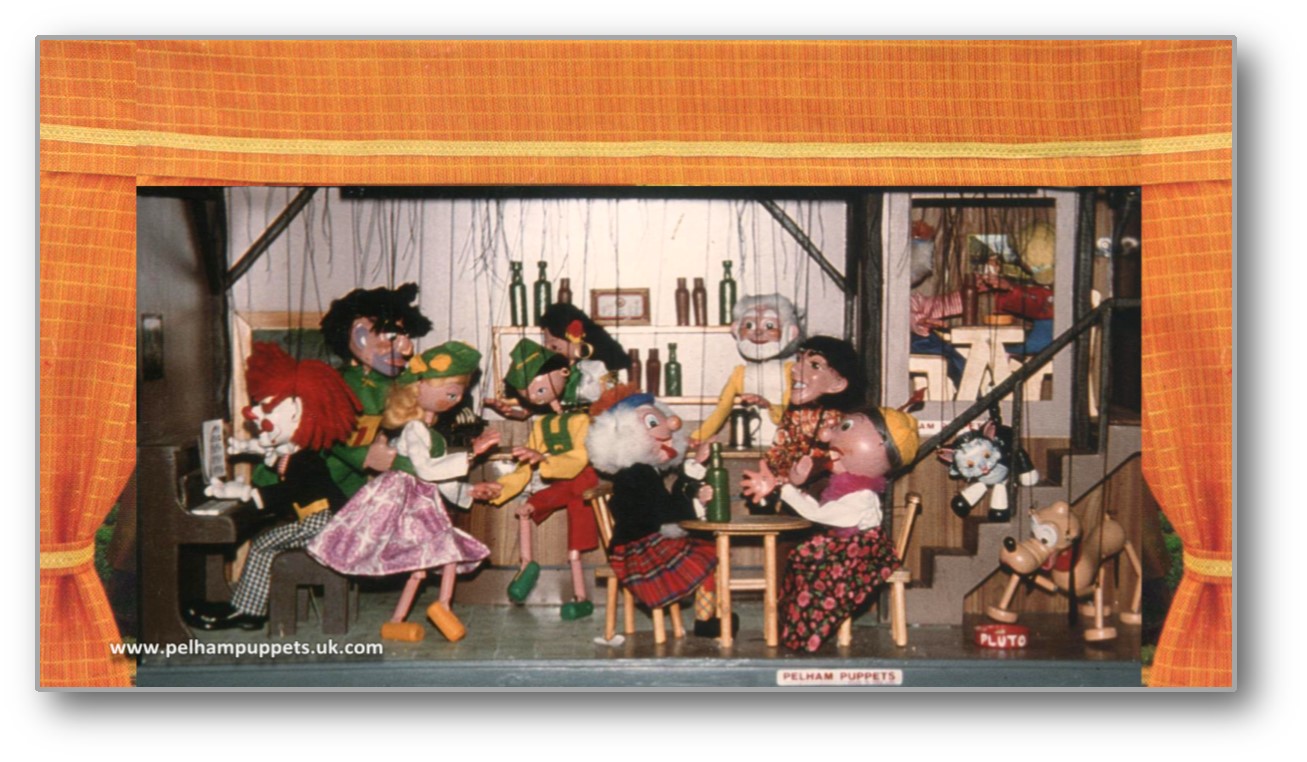 The animated units that were exported to the USA or far flung places like Australia were sold rather than hired to the customers due to carriage and transport costs. This made it necessary to fix the puppets to the floor of the scenes with wire so they would not get entangled with each other during transit or if the unit turned was upside down on its travels. On one occasion, Bob stuck a small top hat to the top of one crate that was sent to Melbourne, Australia for a trade fair. One animated unit ended up on the bottom of the North Sea in 1979! A large circus unit that I had spent over four weeks working on reached the destination port, only for it to be dropped accidentally into the harbour as it was being lifted by crane off the ship!
The animated units that were exported to the USA or far flung places like Australia were sold rather than hired to the customers due to carriage and transport costs. This made it necessary to fix the puppets to the floor of the scenes with wire so they would not get entangled with each other during transit or if the unit turned was upside down on its travels. On one occasion, Bob stuck a small top hat to the top of one crate that was sent to Melbourne, Australia for a trade fair. One animated unit ended up on the bottom of the North Sea in 1979! A large circus unit that I had spent over four weeks working on reached the destination port, only for it to be dropped accidentally into the harbour as it was being lifted by crane off the ship!
From 1980 onwards the large Display Puppets began to be installed into the Animated Units. Although these looked visually impressive, these puppets were really for display use only and very heavy, so the movement on each figure was generally restricted to ‘arm waving.’ That being said, I have always liked the Unit I made up of Snow White and the seven dwarfs in November 1980 which went on display in Hamley’s Toy Shop window in Regent Street London that Christmas.
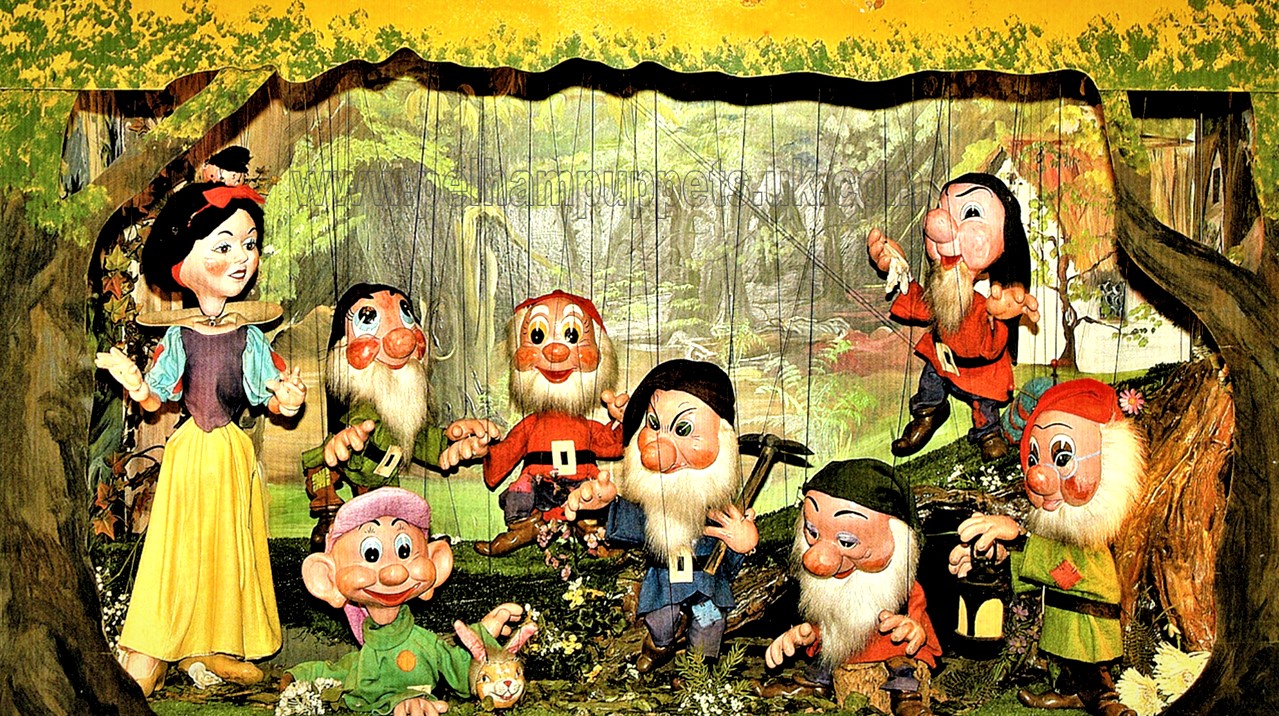
Bob recognised the potential the display units could have for educational purposes, fundraising for charities as well as their ability to promote the sale of his puppets. He had intended to develop this area further and, after his untimely death, the company did try to do so. But the demise of the manufacturing side of the business did not allow for further development in spite of the fact that this was the only department that was showing signs of progress and expansion in the early 1980s.
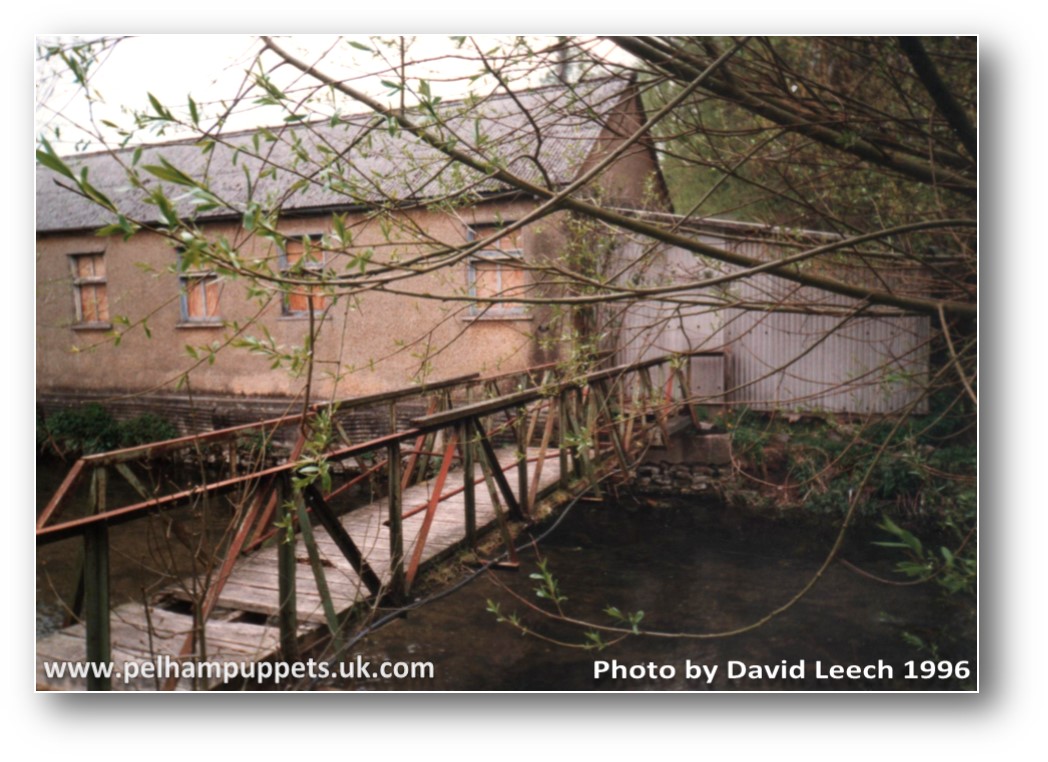 Photo: Taken in 1996 this photograph shows the animated hall with the footbridge spanning the River Kennet in the foreground. The footbridge led right into the Assembly Room and was manufactured by Albert Smith from Mildenhall who had his blacksmith business in Marlborough and together with Bob Pelham and a few of the men who worked in the factory, they placed it into position to enable access from the main factory area south of the river to the newly built hall and other three buildings (the moulding and scarping rooms and store,) acquired in 1963. The hall was demolished in 1997, along with the footbridge.
Photo: Taken in 1996 this photograph shows the animated hall with the footbridge spanning the River Kennet in the foreground. The footbridge led right into the Assembly Room and was manufactured by Albert Smith from Mildenhall who had his blacksmith business in Marlborough and together with Bob Pelham and a few of the men who worked in the factory, they placed it into position to enable access from the main factory area south of the river to the newly built hall and other three buildings (the moulding and scarping rooms and store,) acquired in 1963. The hall was demolished in 1997, along with the footbridge.
The photographs below shows the full 18-foot width Hostelry Scene, then I have included each section so they can be seen in more detail. I have not cropped the pictures and one can just see the Hansel & Gretel Unit underneath on the first image and you can see there are Mini-Units under the other two as well. The fourth picture is Geppetto’s Workshop made in 1983.

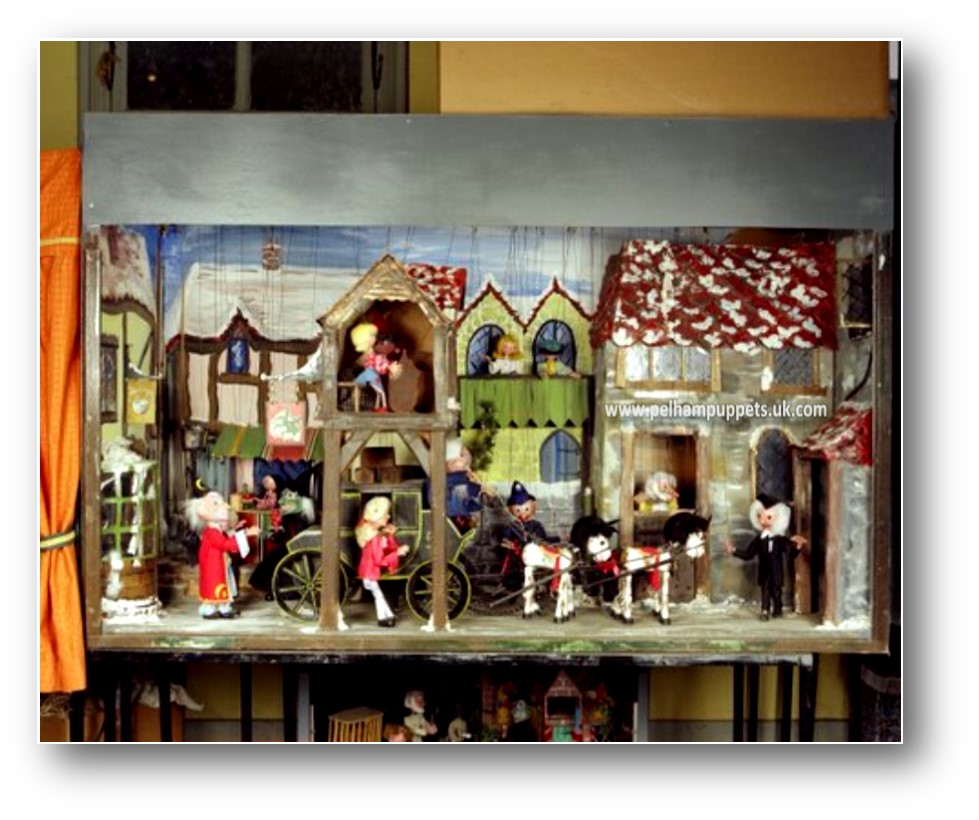
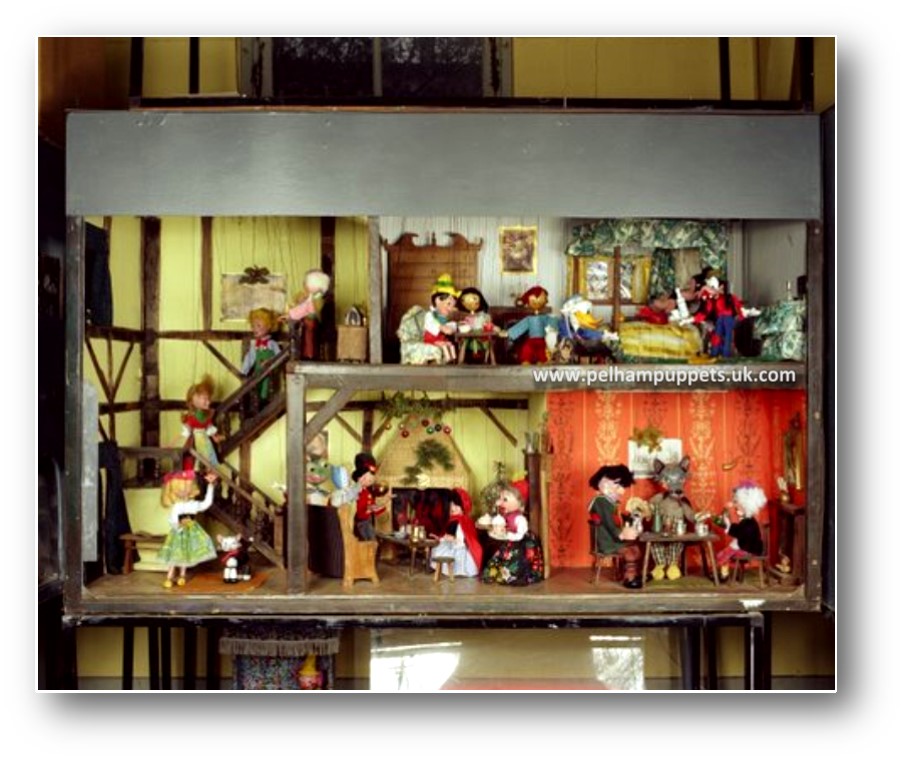
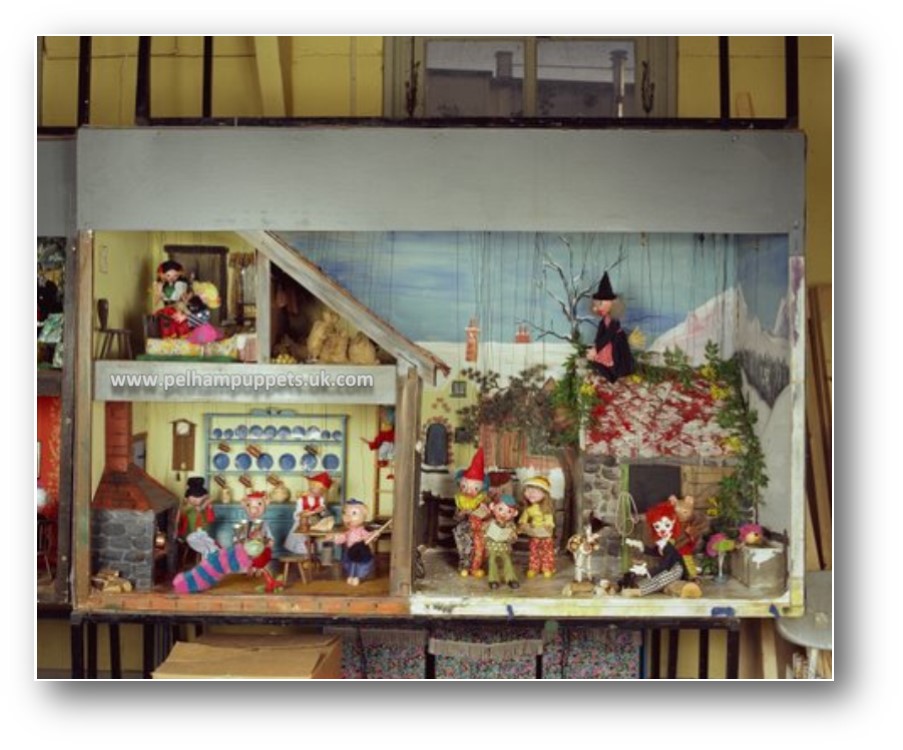
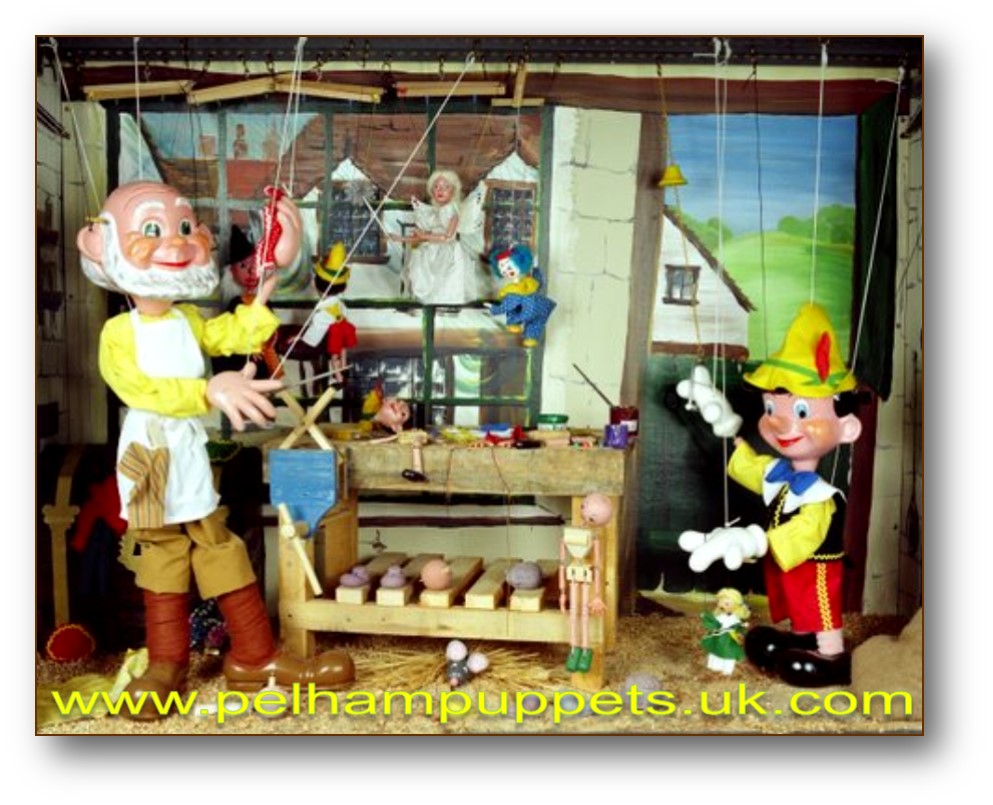
During the life of the company, only four people actually worked on producing the completed scenes for the display units apart from Bob himself and these were Sid Long, Frank Lawton, myself and, after I left the company, Andrew Witts. Below are some of the hundreds of Animated Display Units that were made in the 1960s and 1970s.

Left: Hansel and Gretel Right: Dick Whittington

Left: Mushroom Scene Right: Night before Xmas

Left: Junior range Village Square Right: Village Carol Singers

Left: The Toy Shop Right: The Toy Shop Window. Note the ‘Animated Unit Display’ in the window on the right.

Left: Village Square Dancers Right: The Farmyard
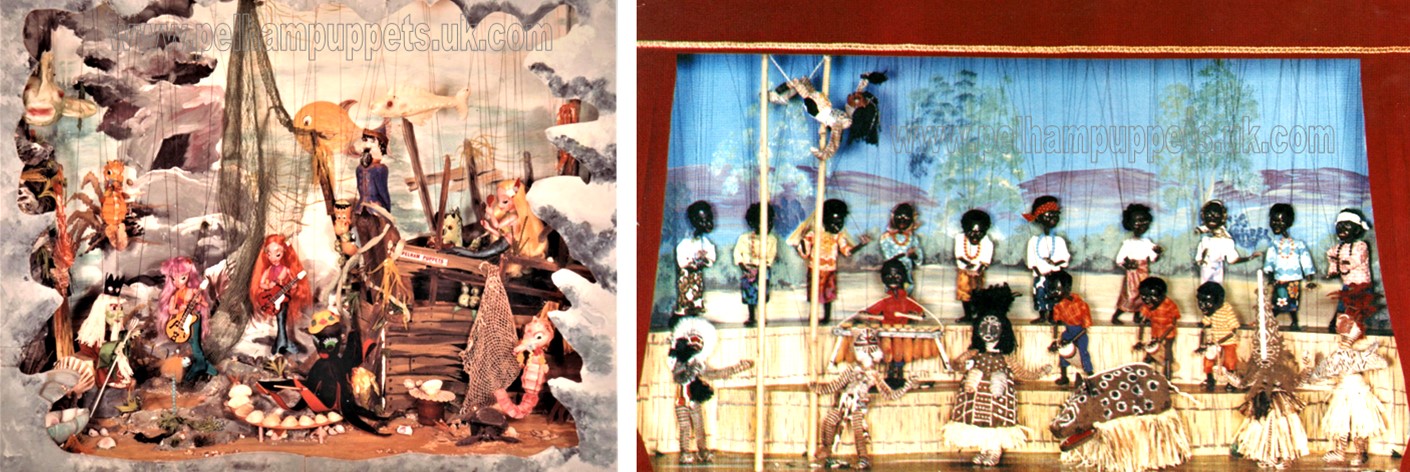
Left: Underwater Scene (1968) This unit first went on display in a Santa’s grotto in Oxford but was later sold to a customer in Switzerland. Right: Makishi Dancers (1971) This was specially made for a customer in Zambia and the dancers were copied exactly in every detail from photographs supplied by the customer.

Left: The Moon Landing Right: The Moon Landing Harrod’s Window Display, Christmas 1962.
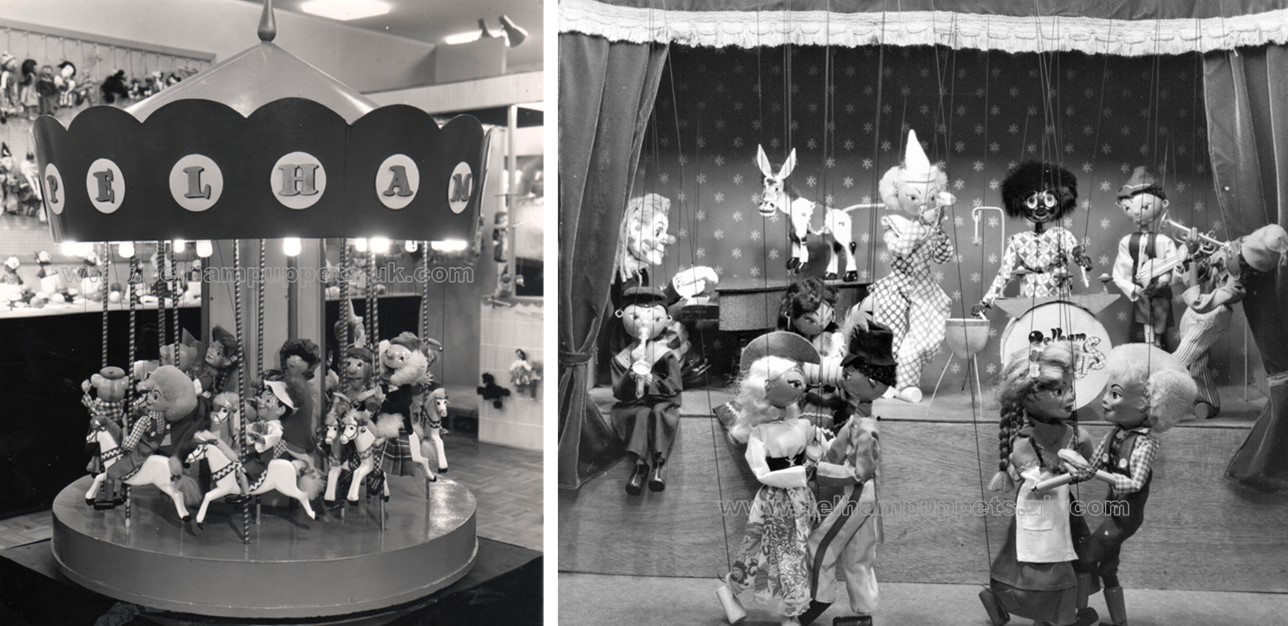
Left: The Roundabout 1966 Right: The Small Band 1962.
Below left: A Corner Unit designed by Mrs Pelham in 1981 for the new kiosk in Hamleys. Right: Completing a three-piece Gulliver scene for Selfridges on October 30th, 1981. This was my final day employed at Pelham Puppets before moving to Weymouth Dorset where I set up my own Puppet Theatre in 1983 at Weymouth Pavilion Theatre.
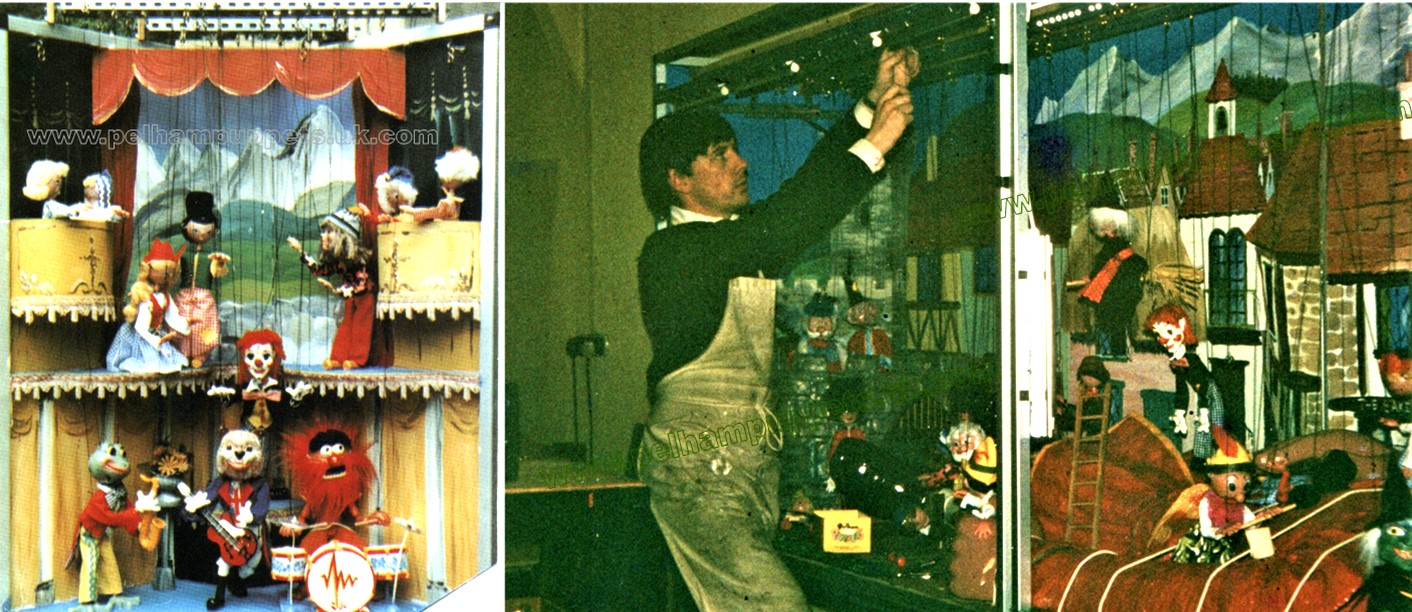
For many years Bob had always wanted to build a permanent puppet theatre, together with a museum and café. One was built in the disused store next to the Scraping Room in 1971, but this was used only once. It was in 1977 that he finally managed together with Jan Bussell of the Hogarth Puppets to consider a number of possible buildings in Marlborough for this purpose, but nothing seemed suitable or viable. In 1979, he decided to set aside an existing building that he had bought in 1977 and turn that into a permanent puppet theatre and I was given the job of helping him to design and build it!
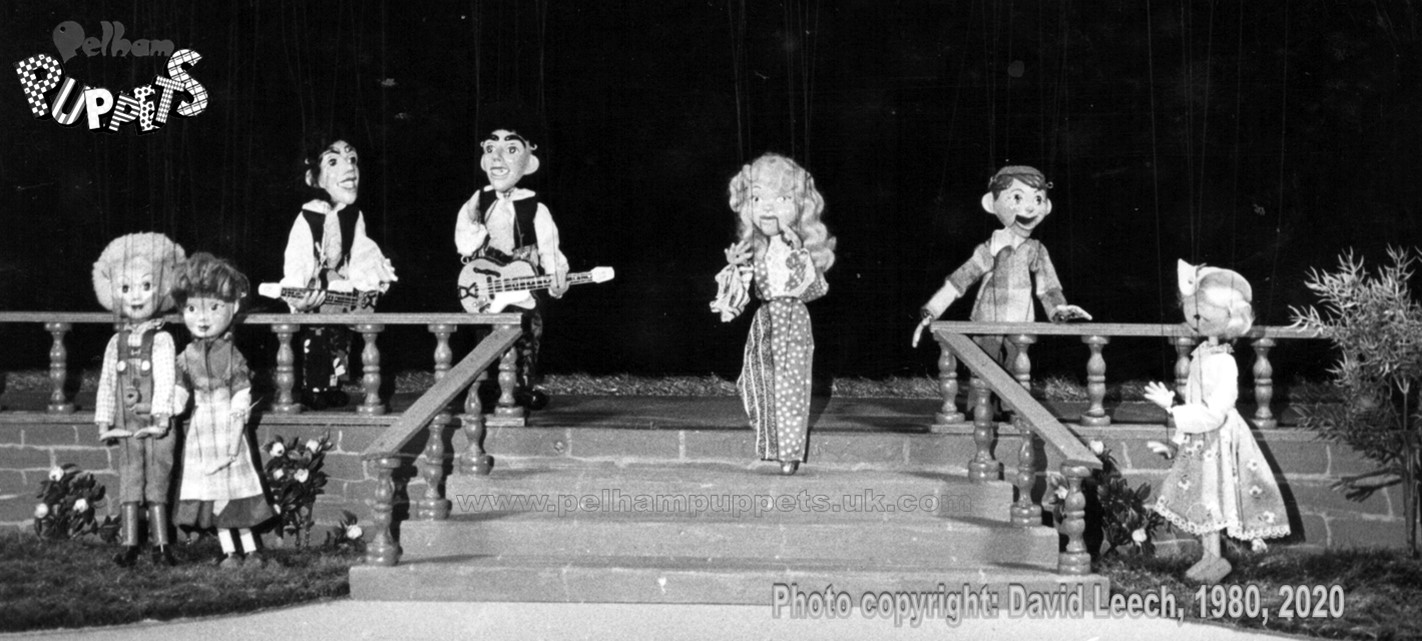
Photo: A scene from the Puppet Theatre in 1980. At first, the scenes were set with black velvet background but this was soon replaced with painted scenery.
By the end of 1979, the puppet stage had been constructed and set up at one end of the Animated Hall and within weeks of its completion, we were staging small shows for visiting school parties. The plan was to relocate the stage to the other building in 1980, after the building had the needed seating and interior décor installed and created. Sadly, Bob Pelham died before this came to fruition. Although Mrs Pelham expressed her intention to continue with the plan on a smaller scale, this never materialised due to the continuing fall in puppet sales and production.
The photos below show the puppet stage set up at one end of the Animated Hall. Left to right: Keith Huntley, Andrew Witts, Eileen Sims-Neighbour and David Leech (aka Me!) The photo on the left is a view of the hall from the stage. Behind the curtain on the right is Frank Lawton. He had been using the floor space to design the playout for the stand at the forthcoming Toy Fair in Earl’s Court, London. Frank used to pack the completed units, have them loaded into his car and trailer to take them to toy shops all over the country. (Both photos were taken on the same day in December 1980.)

The photos below left, show us in rehearsal in December 1980. The Miss Piggy is one I made up for the show using head and body parts that Mr Pelham had been working on over the previous three years. The two ‘Monsters’ either side are puppets I made specially for this show – I still have these two puppets to this day. The only Pelham Puppet in the photo is Animal Muppet which I am holding. Right: That’s me (again!) working on a unit in July 1978.
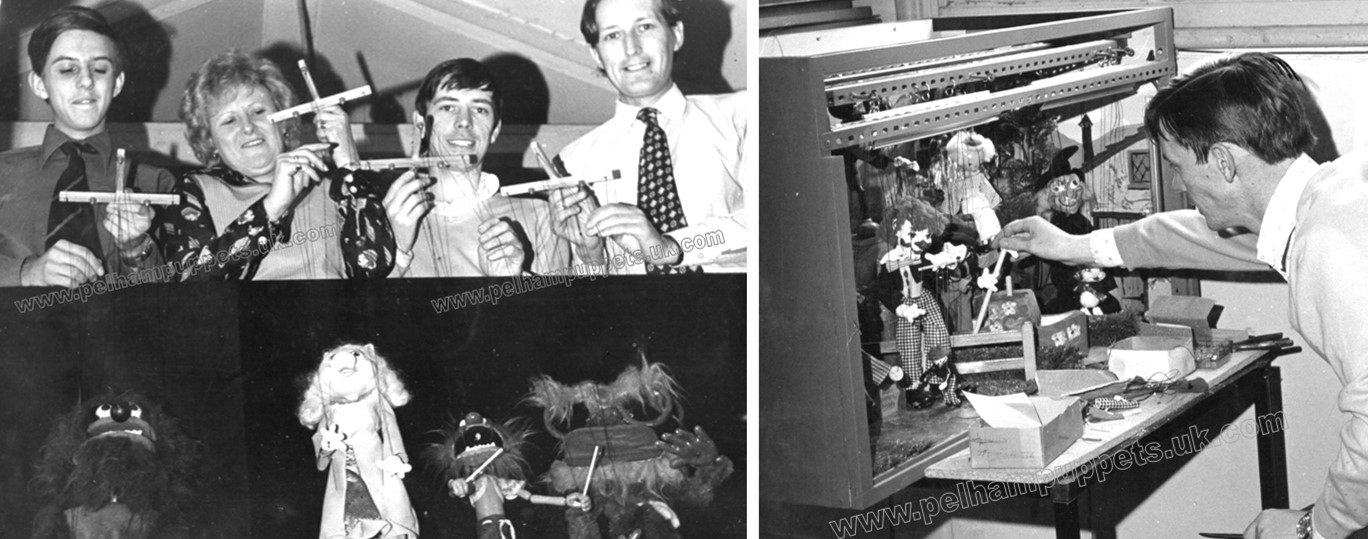
When I think back to my daily work all those years ago, building the scenes for the animated display units, I can still ‘see’ Gepetto painting the scene before him, or Bimbo enthusiastically playing the piano in the corner or Sandy MacBoozle with the bottle firmly fixed to the hand having a jolly conversation with Mrs O’Blige.
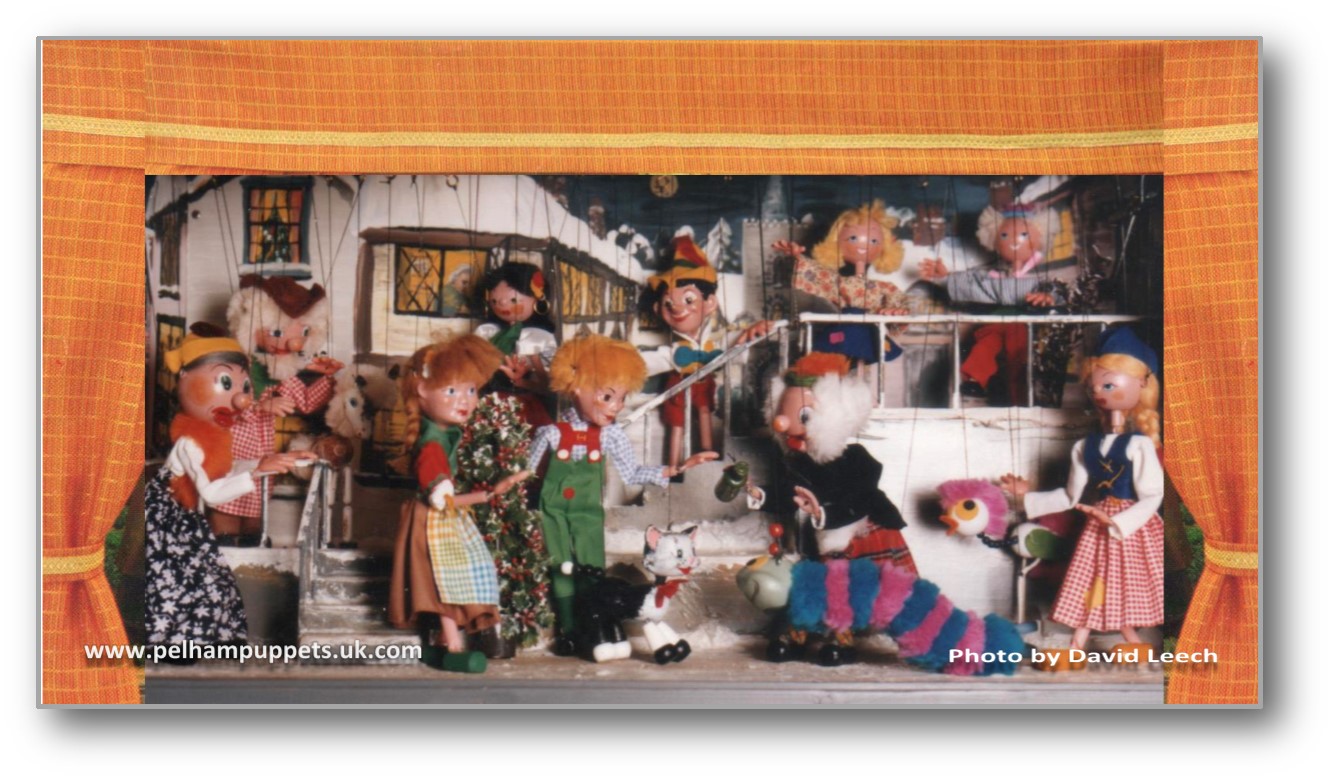 Some of the animated display units have survived still in working order and can be seen in museums or private collections. They perhaps squeak a little more loudly than they once did but you can still see the little characters, dancing, chattering, repeatedly, eternally and uncomplainingly. Mr Pelham, I’m sure would most certainly smile with approval to learn that his puppets are still bringing pleasure to people, young and old alike. He was unconcerned about ‘big business.’ His interest lay in the absorbing art of puppet making and the enjoyment that it brings to so many people, as he once said, “It really is a fascinating hobby and, believe me, it wasn’t the hope of making money that turned my attention to puppets but a genuine creative interest.”
Some of the animated display units have survived still in working order and can be seen in museums or private collections. They perhaps squeak a little more loudly than they once did but you can still see the little characters, dancing, chattering, repeatedly, eternally and uncomplainingly. Mr Pelham, I’m sure would most certainly smile with approval to learn that his puppets are still bringing pleasure to people, young and old alike. He was unconcerned about ‘big business.’ His interest lay in the absorbing art of puppet making and the enjoyment that it brings to so many people, as he once said, “It really is a fascinating hobby and, believe me, it wasn’t the hope of making money that turned my attention to puppets but a genuine creative interest.”
Factory Tour – Conclusion
There were a total of 16 departments in the factory in addition to the stores, offices and stock room. Bob ‘s office was fairly small and functional with his desk, a drawing board and a small display cabinet with a selection of puppets, including the original MacBoozle. Below are a few of the puppets that were on display in his cabinet:
Left: Wags the Dog; centre: Samuel and David, Bible story characters. These were made for Bob’s brother, Tom who was a Minister living in India. Tom would use the puppets in his ministry as teaching aids and over time, built up a large, exclusive collection of puppets. Right: a Mermaid puppet. These were produced in 1968 and were only sold in Hamleys and Harrods and of course, were included in the Animated Display Unit that was sent to a store in Switzerland.
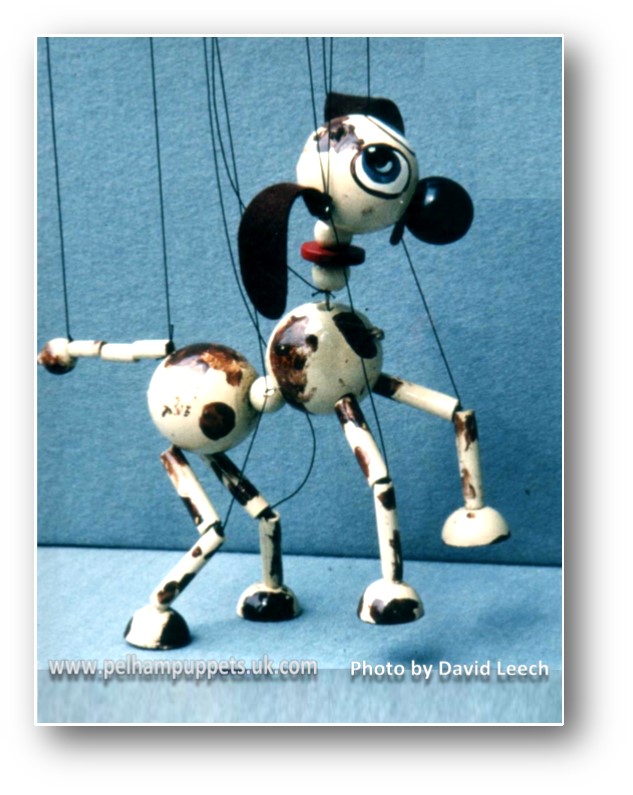 Wags the Dog
Wags the Dog
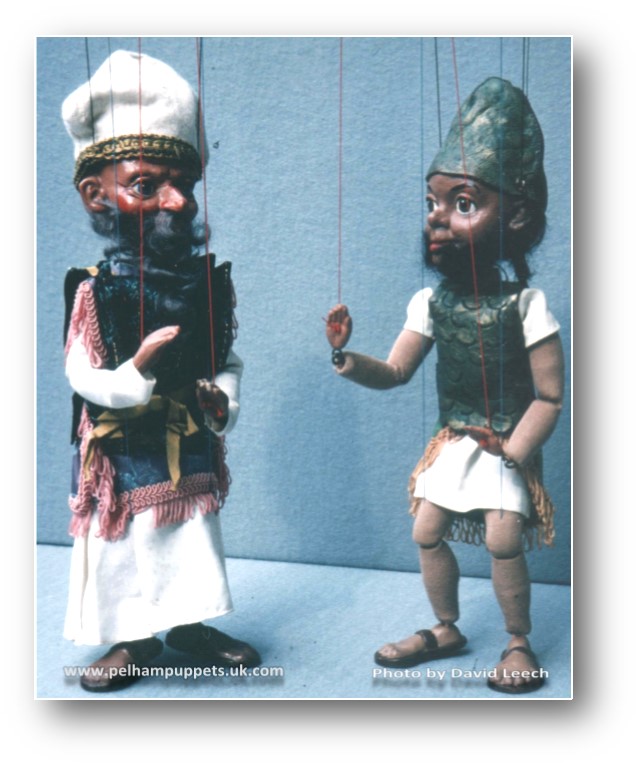 Bible Story character puppets, Samuel and David
Bible Story character puppets, Samuel and David
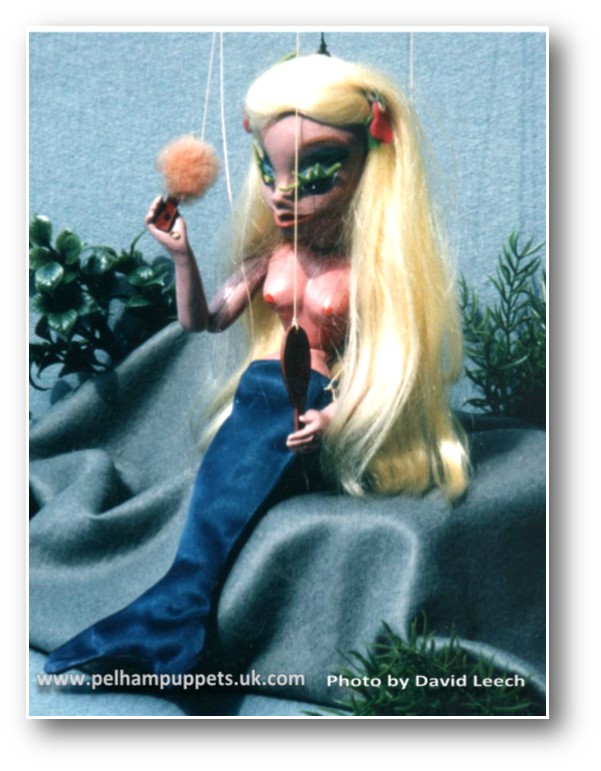 Mermaid
Mermaid
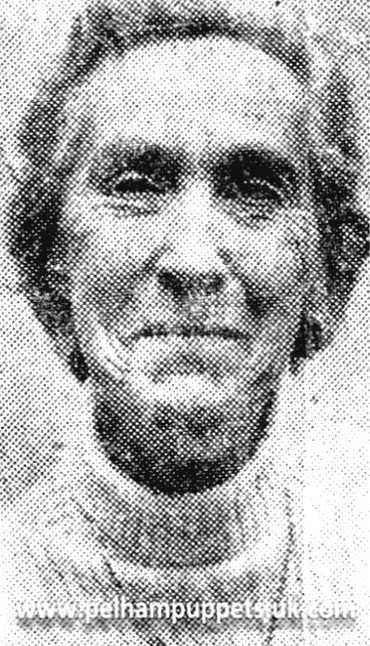 Next to his office one would find Mrs Lilian Ross, his personal assistant and later the Company Finance Director. She began working as secretary for Mr Harrison late in 1950 and from 1956 she took over managing the “business side of things” setting weekly production targets and all aspects of sales and company records. In fact, one could say she was “in charge of the place” since Bob relied on her to address any problems that arose. Paying tribute to Mrs Ross, Councillor Nick Fogg of Marlborough recalled, “Lilian’s rooted common-sense made her indispensable at Pelham Puppets. Amidst all that creativity her cool-headed ability to pick up everything was vital to the growth to international fame of this remarkable company. “Her family and working commitments did not prevent her becoming involved in the wider community, a number of organisations benefited from her verve and enthusiasm is too numerous to mention.”
Next to his office one would find Mrs Lilian Ross, his personal assistant and later the Company Finance Director. She began working as secretary for Mr Harrison late in 1950 and from 1956 she took over managing the “business side of things” setting weekly production targets and all aspects of sales and company records. In fact, one could say she was “in charge of the place” since Bob relied on her to address any problems that arose. Paying tribute to Mrs Ross, Councillor Nick Fogg of Marlborough recalled, “Lilian’s rooted common-sense made her indispensable at Pelham Puppets. Amidst all that creativity her cool-headed ability to pick up everything was vital to the growth to international fame of this remarkable company. “Her family and working commitments did not prevent her becoming involved in the wider community, a number of organisations benefited from her verve and enthusiasm is too numerous to mention.”
Lilian became President of the Chamber of Trade and in 1975, she was co-opted onto Marlborough Town Council and, within 18 months, had become Mayor. She remained with Pelham Puppets well beyond her retirement date and left the Company in May 1983. A few years later she told me, “After all those years I was with the Company and now I’ve left, I don’t actually own a single puppet myself!” She died in Wootton Bassett Care Home aged 97, in 2013. There’s more info about Mrs Ross here.
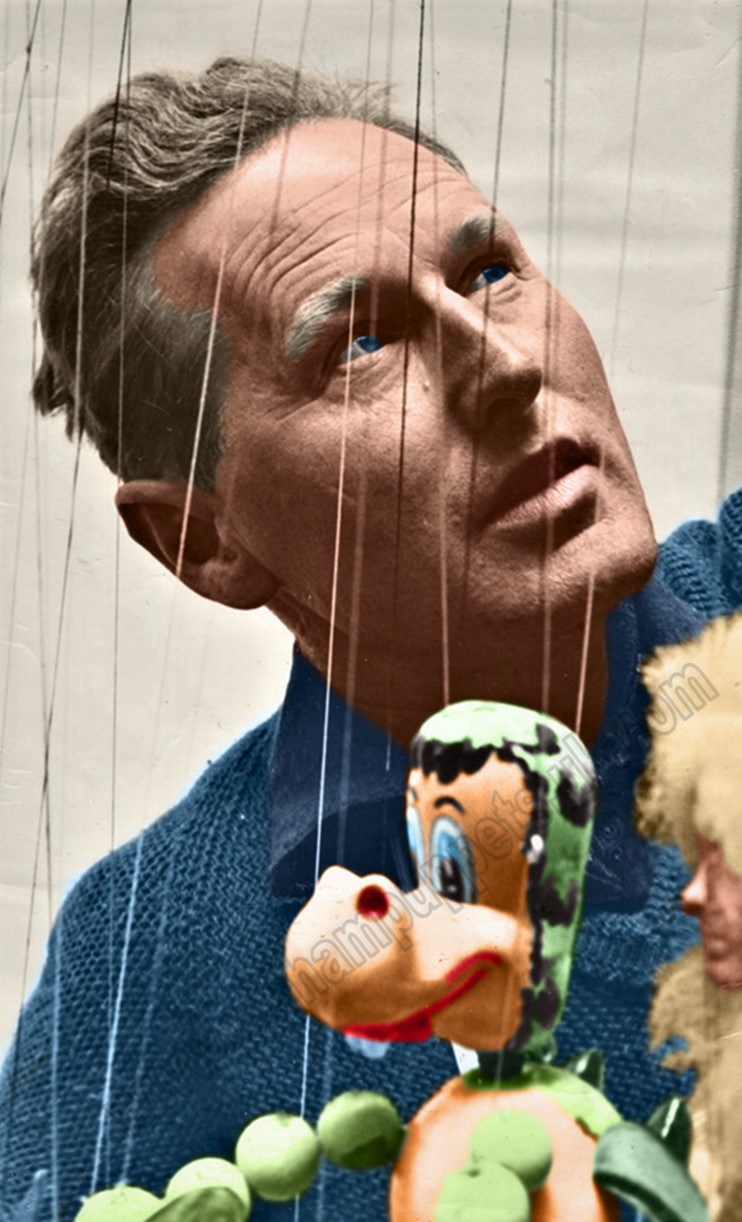 2017 marked the 70th anniversary for Pelham puppets and this was marked by the Marlborough Puppet Festival. It was a celebration of the work and legacy of the man who, not only produced millions of puppets that were sold worldwide, but also made a major contribution to the local community including at one time, becoming the largest employer in town.
2017 marked the 70th anniversary for Pelham puppets and this was marked by the Marlborough Puppet Festival. It was a celebration of the work and legacy of the man who, not only produced millions of puppets that were sold worldwide, but also made a major contribution to the local community including at one time, becoming the largest employer in town.
Now, apart from the fact that the area where the factory stood is called “Pelhams Court” (Bob would certainly have not approved the “s” added to his name!) there is no sign that the factory ever existed. No longer is there the sound of drills humming, hammers tapping or the aroma of sawdust and coffee, although the ducks still paddle and quack along that same stretch of the River Kennet that ran through the factory site. Even so, Pelham Puppets can still cast their magical spell over people especially when they see them in these animated display units or eagerly performing their antics in the hands of some young puppet master.
Pelham Puppets appeared at the “right time.” Soon after launching his puppet making venture Bob Pelham said, “The time will come when Pelham Puppets will be a name that everyone knows!” When one considers the demand for his puppets and the fact that over nine million puppets were produced over a 33 years – and their popularity even today, over 75 years later, I think he was right.
“PELPOP” – The story of Pelham Puppets and details of the factory production over the years and lots of information about the puppets can be found in the book, PELHAM PUPPETS – A Collector’s Guide.
To return to the top of the previous page, click HERE.
